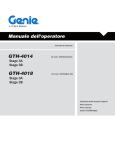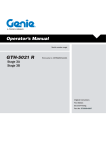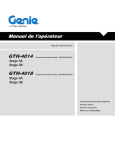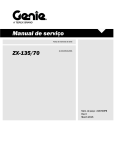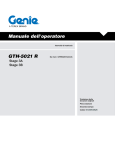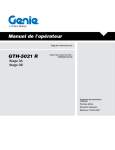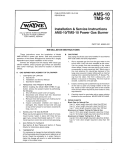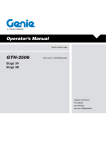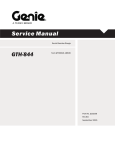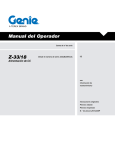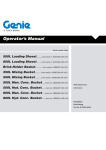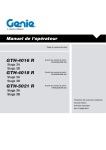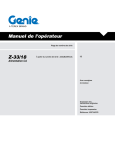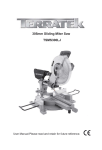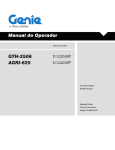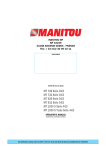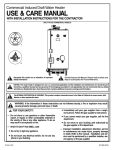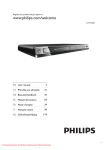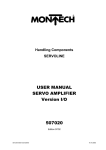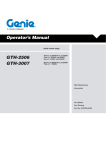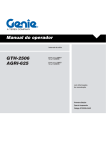Download from SN GTH401414-101, GTH-4014 (PN
Transcript
Operator’s Manual Serial number range GTH-4014 From serial n.: GTH401414-101 GTH-4018 From serial n.: GTH401814-101 Stage 3A Stage 3B Stage 3A Stage 3B Original Instructions First Edition First Printing Part No. 57.0009.0608 January 2014 First Edition - First Printing Contents Introduction........................................................... 1 Symbol and Hazard Pictorials Definitions............ 5 General Safety..................................................... 6 Work Area Safety................................................ 10 Safety Precautions............................................. 18 Legend............................................................... 21 Controls.............................................................. 22 Inspections......................................................... 28 Operating Instructions........................................ 43 Parking and Storage........................................... 61 Transport and Lifting Instructions....................... 63 Maintenance....................................................... 66 Attachments....................................................... 75 Specifications..................................................... 83 Load Charts........................................................ 84 Test.................................................................. 108 EC Declaration of Conformity........................... 111 TEREX Global GmbH Copyright © 2014 by Terex Corporation Muhlenstrasse 26 8200 Schaffhausen Switzerland First Edition: First Printing, January 2014 Technical Assistance Service Telephone: +39 075 9418129 +39 075 9418175 e-mail: [email protected] II Genie is a registered trademark of Terex South Dakota, Inc. in the U.S.A. and many other countries. “GTH” is a trademark of Terex South Dakota, Inc. GTH-4014, GTH-4018 Part No. 57.0009.0608 First Edition - First Printing January 2014 Introduction About This Manual Product Identification Genie appreciates your choice of our machine for your application. Our number one priority is user safety, which is best achieved by our joint efforts. This book is an operation and daily maintenance manual for the user or operator of a Genie machine. The machine serial number is located on the serial label. Serial number stamp This manual should be considered a permanent part of your machine and should remain with the machine at all times. If you have any questions, contact Genie. For Options Manuals (if equipped): • Key Pad Unlocking Device (Option part number 58.2513.1089) • Radio Mp3 (Option part number 58.2513.1093) PLS visit our webpage at www.genielift.com/en/service-support/manuals Homologation plate (if present) Serial label (if present) Intended Use A variable reach rough terrain forklift truck is defined as a wheeled type truck a pivoting boom, which may be equipped with various attachments for picking, transporting and placing loads with the established load range charts. Use of this product in any other way is prohibited and contrary to its intended use. Part No. 57.0009.0608 GTH-4014, GTH-4018 1 January 2014 First Edition - First Printing Introduction Bulletin Distribution and Compliance Contacting the Manufacturer Safety of product users is of paramount importance to Genie. Various bulletins are used by Genie to communicate important safety and product information to dealers and machine owners. The information contained in the bulletins is tied to specific machines using the machine model and serial number. Distribution of bulletins is based on the most current owner on record along with their associated dealer, so it is important to register your machine and keep your contact information up to date. To ensure safety of personnel and the reliable continued operation of your machine, be sure to comply with the action indicated in a respective bulletin. At times it may be necessary to contact Genie. When you do, be ready to supply the model number and serial number of your machine, along with your name and contact information. At minimum, Genie should be contacted for: • Accident reporting • Questions regarding product applications and safety • Standards and regulatory compliance information • Current owner updates, such as changes in machine ownership or changes in your contact information. See Transfer of Ownership, below. Transfer of Machine Ownership Taking a few minutes to update owner information will ensure that you receive important safety, maintenance and operating information that applies to your machine. Please register your machine by visiting us on the web at www.genielift.co.uk. 2 GTH-4014, GTH-4018 Part No. 57.0009.0608 First Edition - First Printing January 2014 Introduction Danger DANGER Failure to obey the instructions and safety rules in this manual will result in death or serious injury. WARNING Do Not Operate Unless: 55 You learn and practice the principles of safe machine operation contained in this operator’s manual. 1.Avoid hazardous situations. Know and understand the safety rules before going on to the next section. 2. Always perform a pre-operation inspection. 3. Always perform function tests prior to use. 4. Inspect the workplace. 5. Only use the machine as it was intended. CAUTION NOTICE 55 You read, understand and obey the manufacturer’s instructions and the safety rules, the safety and operator’s manuals, and the decals applied on the machine. 55 You read, understand and obey the employer’s safety rules and work-site regulations. 55 You read, understand and obey all applicable governmental regulations. 55 You are properly trained to safely operate the machine. PROTECT THE ENVIRONMENT Part No. 57.0009.0608 GTH-4014, GTH-4018 3 January 2014 First Edition - First Printing Introduction Hazard Classification Standards Safety alert symbol - used to alert you to potential personal injury hazards. Obey all safety messages that follow this symbol to avoid possible injury or death DANGER DANGER Indicates a hazardous situation which, if not avoided, will result DANGER in death or serious injury. WARNING DANGER Indicates a hazardous situation WARNING CAUTION WARNING NOTICE CAUTION WARNING which, if not avoided, could result in death or serious injury. DANGER PROTECT THE NOTICE ENVIRONMENT CAUTION Indicates a hazardous situation WARNING PROTECT THE ENVIRONMENT which, if not avoided, could result NOTICE in minor or moderate injury. CAUTION CAUTION PROTECT THE ENVIRONMENT NOTICE The following standards and/or regulations apply to this machine: Directive 2006/42/EC Machinery Directive 2008/104/EC Electromagnetic compatibility 2000/14/CE Environment Acoustic Emissions EN 1459:1998+A3:2012 Safety Sign Maintenance Replace any missing or damaged safety signs. Keep operator safety in mind at all times. Use mild soap and water to clean safety signs. Do not use solvent-based cleaners because they may damage the safety sign material. NOTICE PROTECT THE ENVIRONMENT Indicates a property damage message. PROTECT THE ENVIRONMENT 4 GTH-4014, GTH-4018 Part No. 57.0009.0608 First Edition - First Printing January 2014 Symbol and Hazard Pictorials Definitions Tip-over hazard Electrocution hazard Maintain required Crush hazard. clearance. No people under load Read the operator's manual. Crush hazard. Apply maintenance collar Always wear seat belt. Explosion hazard Do not use. Crush hazard. Keep away from moving parts. Crush Hazard Keep clear of moving parts. Burn hazard. Do not loosen cap until cool. Explosion/burn hazard No smoking. No open flame. Burn Hazard Allow surfaces to cool. Crush hazard Keep away from moving parts Allow engine compartment access Explosion/burn hazard No smoking. No open flame. Fall hazard Keep load low Do not use starting aids Explosion hazard Tip-over hazard Levelling operation Crush hazard. Crush hazard. Work platform use Refer to load charts and manual Tip-over hazard Keep away from outriggers. Part No. 57.0009.0608 GTH-4014, GTH-4018 5 GTH-4014, GTH-4018 237726 215646 237720 09.4618.1423 215644 09.4618.1713 09.4618.1713 65 mm 09.4618.0920 237726 185 mm 09.4618.0924 09.4618.0923 90 mm 09.4618.1674 09.4618.1423 35 mm 215644 84 mm 09.4618.1423 35 mm 09.4618.1674 09.4618.0924 09.4618.0923 90 mm 09.4618.0923 09.4618.1713 215646 09.4618.0923 09.4618.0924 65 mm 09.4618.1674 50 mm 6 50 mm 75 mm 09.4618.0922 100 mm 09.4618.0922 09.4618.1458 09.4618.0922 175 mm 09.4618.0920 09.4618.1458 09.4618.1458 237720 09.4618.0920 January 2014 First Edition - First Printing General Safety for Stage 3A Part No. 57.0009.0608 46 mm 65 mm 46 mm 78 mm Part No. 57.0009.0608 GTH-4014, GTH-4018 215646 09.4618.1423 09.4618.0933 09.4618.1683 Pmax: 6,4 kg/cm2 141 mm 09.4618.1683 215645 84 mm 09.4618.1423 09.4618.0933 125 mm 120 mm 113 mm 74 mm 09.4618.1375 09.4618.1375 215646 $OO ULJKWV UHVHUYHG 215648 0° 09.4618.1679 480 mm 09.4618.1423 09.4618.1679 0DWHULDO 6SHFLILFDWLRQV DQG FRORU WR FRPSO\ ZLWK *(6 237721 &RS\ULJKW E\7HUH[ 7KLV DUWZRUN LV WKH SURSHUW\ RI 7HUH[ DQG PXVW EH VXUUHQGHUHG XSRQ UHTXHVW 6XSSOLHU 7KLV DUWZRUN PD\ QRW EHPRGLILHGRUDOWHUHGZLWKRXW DXWKRU DSSURYDO 'LPHQVLRQV K [ Z[ &RUQHU 5DGLXV *HQLH VDIHW\ UHG LOOXVWUDWLRQ %ODFN 5XOHV 7H[W ,OOXVWUDWLRQV ,62 <HOORZ EDFNJURXQG &RORUV $ (&1 *7+ 3DUW 1XPEHU $ 237721 09.4618.1679 215645 09.4618.0933 09.4618.1375 237720 215644 09.4618.1683 215648 215644 237720 09.4618.0933 215646 First Edition - First Printing January 2014 General Safety for Stage 3A 7 237726 215646 215644 90 mm 237720 09.4618.1423 09.4618.0920 237726 185 mm 09.4618.0924 09.4618.1713 09.4618.1713 65 mm 09.4618.1674 09.4618.1423 215644 84 mm 09.4618.1423 35 mm GTH-4014, GTH-4018 50 mm 8 35 mm 09.4618.1674 09.4618.0923 09.4618.0924 09.4618.0923 90 mm 09.4618.0923 09.4618.1713 215646 09.4618.0923 09.4618.0924 65 mm 09.4618.1674 50 mm 75 mm 09.4618.0922 100 mm 09.4618.0922 09.4618.1458 09.4618.0922 175 mm 09.4618.0920 09.4618.1458 09.4618.1458 237720 09.4618.0920 January 2014 First Edition - First Printing General Safety for Stage 3B Part No. 57.0009.0608 46 mm 65 mm 46 mm 78 mm Part No. 57.0009.0608 GTH-4014, GTH-4018 215646 09.4618.1423 09.4618.0933 09.4618.1683 Pmax: 6,4 kg/cm2 141 mm 09.4618.1683 215645 84 mm 09.4618.1423 09.4618.0933 125 mm 120 mm 113 mm 74 mm 09.4618.1375 09.4618.1375 215646 $OO ULJKWV UHVHUYHG 215648 0° 09.4618.1679 480 mm 09.4618.1423 09.4618.1679 0DWHULDO 6SHFLILFDWLRQV DQG FRORU WR FRPSO\ ZLWK *(6 237721 &RS\ULJKW E\7HUH[ 7KLV DUWZRUN LV WKH SURSHUW\ RI 7HUH[ DQG PXVW EH VXUUHQGHUHG XSRQ UHTXHVW 6XSSOLHU 7KLV DUWZRUN PD\ QRW EHPRGLILHGRUDOWHUHGZLWKRXW DXWKRU DSSURYDO 'LPHQVLRQV K [ Z[ &RUQHU 5DGLXV *HQLH VDIHW\ UHG LOOXVWUDWLRQ %ODFN 5XOHV 7H[W ,OOXVWUDWLRQV ,62 <HOORZ EDFNJURXQG &RORUV $ (&1 *7+ 3DUW 1XPEHU $ 237721 09.4618.1679 215645 09.4618.0933 09.4618.1375 237720 215644 09.4618.1683 215648 215644 237720 09.4618.0933 215646 First Edition - First Printing January 2014 General Safety for Stage 3B 9 January 2014 First Edition - First Printing Work Area Safety Overturning Hazards Do not use the levelling control to position an elevated load. Using the load chart, confirm that the load is within the rated capacity of the machine. Do not exceed the rated load. The load center of the fork (if equipped) must be equal to or less than the load center indicated on the load chart. All loads shown on the load chart are based on the machine being on firm ground, the frame being level, the forks being positioned evenly on the carriage, the load being centered on the forks, the tires being properly sized and properly inflated, and the telehandler being in good operating condition. Do not raise a load and then drive to position it. When driving, keep the boom at or below horizontal and keep the load close to the ground. Operate the machine at speeds that will keep the load under control. Start and stop movements smoothly. Do not raise a load unless the load is properly positioned or secured on the forks or approved attachment. If using accessories, read, understand and obey the decals, instructions and manuals with the accessory. Do not raise the load unless the ground can support all forces imposed by the machine. Do not lower a load without retracting the boom first. Do not operate the machine if the load chart is missing. Do not operate the machine in strong or gusty winds. Do not increase the surface area of the carriage or load. Increasing the area exposed to the wind will decrease machine stability. Do not exceed the rated capacity for each configuration. Use extreme care and slow speeds while driving the machine in the travel position across uneven terrain, debris, unstable or slippery surfaces and near holes and drop-offs. Do not raise the boom unless the machine is level. The machine level indicator should be at zero degrees. Do not alter or disable machine components that in any way affect safety and stability. Do not level the machine using the frame levelling control unless the boom angle indicator is at zero degrees or less. Do not work with the load limiting system cut out. 10 Do not replace items critical to machine stability with items of different weight or specification. Do not replace factory-installed tires with tires of different specification or ply rating. Lateral inclination allowed during working phase ± 0,5° GTH-4014, GTH-4018 Part No. 57.0009.0608 First Edition - First Printing January 2014 Work Area Safety Only use the machine on firm ground capable of supporting the maximum combined load of the machine and payload. If the subsoil collapses, the machine could tip over. To avoid any risk of overturning, the following precautions should be taken: • Ask your employer (site manager or manager assistant) if there may be buried pipes, pits, old tanks, cellar floor, dung yards, etc. under the ground onto which the outriggers shall be lowered. • A rough estimate of the ground consistency can be done using the tables and picture in this page. • The resistance of the subsoil is in relation to the ground type and geomorphological characteristics. Table 1 indicates the superficial pressure which is allowed under the outriggers of the machine. Type of ground, geomorphological features Allowable superficial pressure loose, non-compact soil generally speaking, not solid; special precautions needed loamy, peaty,pasty soil rippable, soft ground non-cohesive, well compact soil, sand, gravel rippable soil kg/cm2 N/mm2 2.0 0.2 solid 1.0 0.1 semisolid 2.0 0.2 hard 4.0 0.4 above 10.0 above 1.0 Rocks, concrete, heavy traffic paved roads Make sure the machine (wheels and outriggers) rests on a firm ground to prevent hazardous unstable conditions. If the ground is not firm enough, position some support planks, capable of withstanding the expected loads, under the outriggers or the wheels. In presence of trenches, lower the outriggers at a safe distance from the trench edge. a h a & h = minimum distances The distance (a) from the foot of the overhang shall be adequate to height (h) of the same overhang. If the ground fulfils the required conditions: a:h=1:1 (values with a grey background in table 1) In the case of doubts: a:h=2:1 Table 1 Part No. 57.0009.0608 GTH-4014, GTH-4018 11 January 2014 First Edition - First Printing Work Area Safety Traveling on Slopes Hazards When driving, keep the boom at or below horizontal and keep the load close to the ground. When the machine is unloaded, travel with the forks or attachment downhill. When the machine is fully loaded and on transfer mode (boom fully lowered and retracted): • max inclination driving downhill 9° • max inclination driving uphill 20° • max lateral inclination ± 6° On steep terrain, drive only up and down a hill, and always keep the machine in gear. Do not turn across the slope when the machine is traveling up or down a slope. Limit travel path and speed according to the condition of the ground surface, traction, slope, location of personnel and any other factors which may create a hazard. Never drive the machine unless the mast and equipment are in their proper travel position. Whether a machine will tip over during dynamic machine operation involves many factors that need to be considered. Among these are pavement/ground conditions, stability and slope, as well as machine equipment, operator skill, load position, tire inflation, machine speed, etc. Operators should be properly trained and use their best judgment and experience to take the necessary precautions to prevent a tip-over. Operators must assess the job site variables and avoid exceeding the machine's (or operator's) capabilities for terrain and conditions. Fall Hazards Always wear a seat belt when operating the machine. Always remain completely inside the cab when operating the machine. When getting in and out of the cab, face the machine, use the steps and handrails provided and always maintain three-point contact. Do not use the steering wheel or any other controls as handrails. Additionally, tip-over of a machine is dependent in large part upon operator inputs such as the speed and smoothness of the operation, as well as the position of the attachment and its load. Do not allow riders on the machine or forks. Do not transport or lift personnel with this machine unless it is equipped with an approved work platform. Construction sites and roads will frequently change slope from place to place, can be hard and soft, and change due to construction activities and weather. 12 GTH-4014, GTH-4018 Part No. 57.0009.0608 First Edition - First Printing January 2014 Work Area Safety Collision Hazards Falling Object Hazards Do not put the transmission into gear unless the parking brake is set. Operate the machine at speeds that will keep the load under control. Start and stop movements smoothly. Do not drive the machine if visibility is obstructed. Keep people, equipment and material out of the work area. Do not operate the machine while people are under or near an elevated boom, whether it is loaded or unloaded. Do not raise the boom unless the parking brake is set. Do not operate in conditions without fenders to protect debris from hitting the operator or accumulating on the cab windows. Do not operate the machine with a faulty back-up alarm. The back-up alarm should sound when the machine is in reverse. Be sure the load is secure before lifting it. Do not operate the machine in low light conditions. Operators must comply with employer, job site and governmental rules regarding use of personal protective equipment. Do not drive the machine directly up to anyone. If a radio and/or mp3 player is equipped, keep the volume low enough to hear surrounding environment (i.e. traffic, alarms, people etc.). Do not adjust the controls while driving or manoeuvring a load. Do not drive the machine unless the outriggers are fully retracted. Part No. 57.0009.0608 GTH-4014, GTH-4018 13 January 2014 First Edition - First Printing Work Area Safety Bodily Injury Hazards Damaged Machine Hazards Always adjust the seat and fasten the seat belt before starting the engine. Do not operate the machine with a hydraulic oil or air leak. An air leak or hydraulic leak can penetrate and/or burn skin. Relieve pressure before disconnecting hydraulic lines. Keep away from leaks and pin holes. Use a piece of cardboard or paper to search for leaks. Do not use your hand. Fluid injected into skin must be surgically removed within a few hours by a doctor familiar with this type of injury or gangrene will result. Stay clear of belts and fans when the engine is running. Always operate the machine in a well-ventilated area to avoid carbon monoxide poisoning. Do not use a damaged or malfunctioning machine. Conduct a thorough pre-operation inspection of the machine and test all functions before each work shift. Immediately tag and remove from service a damaged or malfunctioning machine. Be sure all maintenance has been performed as specified in this manual and the appropriate Genie service manual. Be sure all decals are in place and legible. Be sure the operator's and safety manuals are complete, legible and in the storage container located in the cab. Do not attempt to start the machine by towing or pushing. Do not attempt to use the forks or attachments for prying wedged or frozen loads free. Do not push or pull objects or loads with the forks, attachment or boom. Improper contact with components under any cover will cause serious injury. Only trained maintenance personnel should access compartments. Access by the operator is only advised when performing a preoperation inspection. All compartments must remain closed and secured during operation. 14 GTH-4014, GTH-4018 Part No. 57.0009.0608 First Edition - First Printing January 2014 Work Area Safety Component Damage Hazards Do not use any battery or charger greater than 12V to jump-start the engine. Explosion and Fire Hazards Do not start the engine if you smell or detect liquid petroleum gas (LPG), gasoline, diesel fuel or other explosive substances. Do not use the machine as a ground for welding. Do not refuel the machine with the engine running. Do not steer the front tires on dry pavement when the axle differential lock is activated. Refuel the machine and charge the battery only in an open, wellventilated area away from sparks, flames and lighted tobacco. Crush Hazards Do not operate the outriggers while people are in the path of movement. Keep clear of moving parts during machine operation. Set the parking brake, put the transmission in neutral and lower the carriage or the attachment to the ground before leaving the machine. Do not operate the machine in hazardous locations or locations where potentially flammable or explosive gases or particles may be present. Do not spray ether into engines equipped with glow plugs or air intake grid heaters. Do not use air or oxygen for charging the accumulators. Keep clear of elevated components. Support components before performing service. Keep clear of moving parts during machine operation. Burn Hazards Allow hot surfaces to cool before touching or servicing. Part No. 57.0009.0608 GTH-4014, GTH-4018 15 January 2014 First Edition - First Printing Work Area Safety Electrocution Hazards This machine is not electrically insulated and will not provide protection from contact with or proximity to electrical current. Obey all local and governmental regulations regarding required clearance from electrical power lines. At a minimum, the required clearance contained in the chart below must be followed. Do not use the machine as a ground for welding. Always contact the electrical power line owner. The electrical power shall be disconnected or the power lines moved or insulated before machine operations begin. Allow for boom movement, electrical line levelling or sag, and beware of strong or gusty winds. Keep away from the machine if it contacts energized power lines. Personnel on the ground or in the cab must not touch or operate the machine until energized power lines are shut off. Do not operate the machine during lightning or storms. Line Voltage Required Clearance 0 to 50kV 10 ft 3.05 m >50 to 200kV 15 ft 4.60 m >200 to 350kV 20 ft 6.10 m >350 to 500kV 25 ft 7.62 m >500 to 750kV 35 ft 10.67 m >750 to 1000kV 45 ft over 1000kV 13.72 m see below For power lines over 1000kV, the minimum clearance distance must be established by the utility owner or operator or by a registered professional engineer who is a qualified person with respect to electrical power transmission and distribution. 16 GTH-4014, GTH-4018 Part No. 57.0009.0608 First Edition - First Printing January 2014 Work Area Safety Battery Safety Electrocution Hazard Burn Hazards Batteries contain acid. Always wear protective clothing and eye wear when working with batteries. Avoid contact with electrical terminal Avoid spilling or contacting battery acid. Neutralize battery acid spills with baking soda and water. During maintenance or repair works, and while welding, disconnect the battery by turning the cut-out switch (see Inspection for Decals section). Explosion Hazards Keep sparks, flames and lighted tobacco away from batteries. Batteries emit explosive gas. Using the Charger (if equipped), be sure the device works at 12 Volt and doesn't exceed 15 Ampere. Employer's Responsibilities Employers are responsible for providing a safe work environment and for complying with local and national governmental regulations. Personal Safety Be sure that everyone working on or near this machine is familiar with the applicable safety precautions. Part No. 57.0009.0608 GTH-4014, GTH-4018 17 January 2014 First Edition - First Printing Safety Precautions Requisites Of The Machine Operators The operators who use the machine regularly or occasionally (i.e. for transport reasons) shall have the following prerequisites: health: before and during any operation, operators shall never take alcoholic beverages, medicines or other substances that may alter their psycho-physical conditions and, consequently, their working abilities. physical: good eyesight, acute hearing, good co-ordination and ability to carry out all required operations in a safe way, according to the instructions of this manual. mental: ability to understand and apply the enforced rules, regulations and safety precautions. They shall be careful and sensible for their own as well as for the others’ safety and shall desire to carry out the work correctly and in a responsible way. emotional: they shall keep calm and always be able to evaluate their own physical and mental conditions. training: they shall read and be familiar with this handbook, its enclosed graphs and diagrams, the identification and hazard warning plates. They shall be skilled and trained about the machine use. Requisites of the servicemen The personnel charged with the machine maintenance shall be qualified, specialised in the maintenance of telehandlers, and shall have the following prerequisites: physical: good eyesight, acute hearing, good co-ordination and ability to carry out all required maintenance operations in a safe way, according to this manual. mental: ability to understand and apply the enforced rules, regulations and safety precautions. They shall be careful and sensible for their own as well as for the others’ safety and shall desire to carry out the work correctly and in a responsible way. training: they shall read and be familiar with this handbook, its enclosed graphs and diagrams, the identification and warning plates. They shall be skilled and trained about the machine functioning. From a technical point of view, the ordinary maintenance of the machine is not a complex intervention and can be carried out by the machine operator, too, provided he has a basic knowledge of mechanics. The operator shall have a licence (or a driving licence) when provided for by the laws enforced in the country where the machine works. Please, ask the competent bodies. In Italy the operator must be at least 18 year old. 18 GTH-4014, GTH-4018 Part No. 57.0009.0608 First Edition - First Printing January 2014 Safety Precautions Working clothes Personal protective equipment During work, but especially when maintaining or repairing the machine, operators must wear suitable protective clothing: • • • • Overalls or any other comfortable garments. Operators should not wear clothes with large sleeves or objects that can get stuck in moving parts of the machine. Protective helmet. Protective gloves. Working shoes. Under special working conditions, the following personal protective equipment should be used: • Breathing set (or dust mask). • Ear-protectors or equivalent equipment. • Goggles or facial masks. Use only type-approved working clothing in good condition. Part No. 57.0009.0608 GTH-4014, GTH-4018 19 January 2014 First Edition - First Printing Safety Precautions Control Indicators and Interlocks Several control indicators and interlocks have been fitted to the machine. They must never be tampered with or removed. Always perform a function test to check the proper operation of these devices. Never operate a machine that is malfunctioning. If the machine starts to malfunction, immediately stop using it and have it repaired. Load Limiting system The Load Limiting System has been developed to help the operator to maintain the machine longitudinal stability. Audible and visual messages are provided when the limits of longitudinal stability are being approached. However this device cannot replace the experience of the operator. It is up to the user to adopt the necessary safety measures to work within the rated limits of the machine. The Load Limiting System is designed to function only: when the truck is static; • when the truck is on consolidated, stable and level ground; • when the truck is performing loading or placing functions; • when the Load Limiting System is activated (not overridden). The Load Limiting System will only warn the operator in the event of inadequate stability in the longitudinal plane in the forward direction. The Load Limiting System is not intended for warning of the risk of overturning in the case of: • a sudden overload; • travelling with the load in the elevated position; • travelling on rough terrain or on grounds with obstacles and holes; • travelling across a slope or turning on a slope; • driving in bends too fast or too sharp; Adjustments affecting the setting of the Load Limiting System shall be performed only by authorised personnel. 20 Seat Interlock This micro switch is located inside the seat cushion, and it prevents any machine transmission movements if the operator is not correctly seated in the driving seat. Emergency Stop Push-button This device have to be used to stop the machine during an emergency situation. By pressing this button, the engine shuts down while the Load Limiting System stays active. Before restarting the machine, it is necessary to reset the push-button by rotating it clockwise. Enabling Function Switch on Joystick The joystick is equipped with an enabling function switch. This red finger switch must be held pressed down until the joystick functions have been completed; if it is released, the manoeuvre stops. Sensors on Outriggers Each outrigger is equipped with two sensors: • Proximity switch: it tells when the outrigger is less than 10 cm from the ground, cutting out the transmission; • Magnetic codified sensor with target: it tells when the outrigger is fully lowered; The load limiting system changes configuration from "NOT STABILIZED” to “ STABILIZED” the lowered outriggers indicator light switches on. GTH-4014, GTH-4018 Part No. 57.0009.0608 First Edition - First Printing January 2014 Legend 1 13 3 11 14 4 5 9 2 6 12 8 10 7 1. Left/right level indicator 2. Operator’s manual storage (door internal side) 3. Left rear view mirror 4. Rear fish eye mirror 8. Hydraulic oil level gauge (on opposite side of machine) 9. Engine (on opposite side of machine) 10.Forks 5. Boom angle indicator 6. Maintenance collar (on opposite side of machine) 7. Fuel filler 11.Seat belt 12.Outriggers 13.Front/rear level indicator 14.Right rear view mirrors Part No. 57.0009.0608 GTH-4014, GTH-4018 21 January 2014 First Edition - First Printing Controls 31 22 1 29 2 18 4 6 13 16 17 7 9 27 5 20 P 25 28 26 19 ERROR 32 24 21 23 30 8 15 10 12 14 11 3 22 GTH-4014, GTH-4018 Part No. 57.0009.0608 First Edition - First Printing January 2014 Controls Control Panel 2. Transmission control lever - Horn button 17. DPF switch (EU model) 18. Steering column control 3. Seat controls 19. Job-site/road/platform selector 4. Turn signal - Windshield washer/wiper - High beams 20. A/C switch (if equipped) 5. Steer select switch 22. Auxiliary hydraulic circuit switch (if equipped) 6. Load limiting disable selector 23. Mixing bucket switch (if equipped) 7. Load limiting indicator 24. Work lights switch (if equipped) 8. Emergency stop push-button 25. Hazard warning lights switch 9. Instruments panel 26. Emergency pump switch (if equipped) 10. Parking brake switch 27. Gear selection switch 11. Right control handle 28. Chassis levelling switch (if equipped) 12. Heater and air conditioning controls 29. Outriggers switches 13. Diagnostic button 30. Road lights switch 14. Accelerator pedal 31. Hydraulic mixing bucket oil direction switch (if equipped) 1. Steering wheel 15. Brake pedal 16. Ignition switch Part No. 57.0009.0608 21. Cab heater fan switch 32. Hydraulic quick coupling enabling switch (if equipped) GTH-4014, GTH-4018 23 January 2014 First Edition - First Printing Controls 1 Steering wheel 7 Load limiting indicator Turn the steering wheel to the right to turn the front wheels to the right. Turn the steering wheel to the left to turn the front wheels to the left. 2 Transmission control lever - Horn button Move the transmission control lever away from you for forward gear. Move the lever toward you for reverse gear. Move the lever to the center position for neutral. Press the top end lever button and the horn will sound. Release the button and the horn will stop. 3 Seat controls 4 Turn signal - Windshield washer/wiper - High beams Move the lever forward to activate the right turn signal. Move the lever backward to activate the left turn signal. Press the top button at the end of the lever to direct a jet of water onto the cab windscreen. Rotate the lever tip to operate the windscreen wiper. Push the lever down to turn the high beams on (after pushing the Road lights switch 30). Push the lever up to use high beams for intermittent signalling. 5 Steer select switch Rotate the steer selector to the right side to select four-wheel steer. Rotate the steer selector to the middle position to select two-wheel steer. Rotate the steer selector to the left to select crab steer. See “Load Limiting Indicator” section. 24 8 Emergency stop push-button See “Control Indicators and Interlocks” section. 9 Instrument panel 10 Parking brake switch Push the bottom of the rocker switch to turn the parking brake on. Push the top of the switch to turn the parking brake off. 11 Control handle See “Controller movements” section. See “Adjusting the Seat” section. 6 Load limiter disable selector See “Load Limiting Indicator” section. 12 Heater and air conditioning controls 13 Diagnostic button Push the button to scroll the LCD screen menu. 14 Accelerator pedal 15 Brake pedal 16 Ignition switch Turn the key to the position and hold until the glow plugs preheating indicator light turns off; when released, key springs back to pos. I automatically. Turn the key to position P to switch the control from the cab to platform. 17 DPF switch (if equipped) Push the bottom of the rocker switch to enable the DPF regeneration. Push the top of the switch to inhibit the DPF regeneration. 18 Steering column control Unlock the lever on the right-bottom side and pull or push the steering wheel to the required position, then re-lock it. GTH-4014, GTH-4018 Part No. 57.0009.0608 First Edition - First Printing January 2014 Controls 19 Job-site/road/platform selector 26 Emergency pump switch (if equipped) Rotate the steer selector to the left to select jobsite mode. Rotate the steer selector to the middle position to select road transfer mode. Rotate the steer selector to the right side to select platform mode (if present). 20 A/C switch Push the switch to turn the A/C on. Push the switch to turn the A/C off. 21 Cab heater fan switch Push the bottom of the switch to turn the cab heater fan on: first position for low speed and second position for high speed. Push the top of the switch to turn the cab heater fan off. 22 Auxiliary hydraulic circuit switch (if equipped) Push the button to switch the hydraulic directional flow between the two auxiliary lines. 23 Mixing bucket switch (if equipped) Push the bottom of the rocker switch to enable the hydraulic mixing bucket functioning. Push the top of the switch to stop the hydraulic mixing bucket functioning. 24. Work lights switch (if equipped) Push the rocker switch to turn the work lights on: first position for front & boom working lights and second position for front, boom & rear working lights. 25 Hazard warning lights switch (if equipped) Push the bottom of the switch to turn the hazard warning lights on. Push the top of the switch to turn the hazard warning lights off. Part No. 57.0009.0608 Push the switch to activate the emergency pump. Release the switch to release the emergency pump. 27 Gear selection Switch Push the bottom of the rocker switch to select the required speed: each pressure corresponds to the selection of a new speed. 28. Chassis levelling switch (if equipped) Push and hold the switch until the complete execution of the function selected: push the left side to raise the right-hand side of the machine; push the right side to lower the right-hand side of the machine. 29. Outriggers switches Push the top of the switches to extend and lower the outriggers. Push the bottom of the switches to raise and retract the outriggers 30. Road lights switch Push the rocker switch to turn the road lights on: first position for position lights and second position for low beams. 31. Hydraulic mixing bucket oil direction switch (if equipped) Press the switch to regulate the oil flow direction towards right or left: push the top to direct the oil towards left; push the bottom to direct the oil towards right. 32. Hydraulic quick attach enabling switch (if equipped) Push and hold the switch to enable the coupling or the release of the attachment, managed by the control handle GTH-4014, GTH-4018 25 January 2014 First Edition - First Printing Controls 21 20 19 18 17 16 15 °c 22 1230 105 23 14 engine rpm 60 000000.0 13 12 24 ERROR 1 2 3 4 5 6 7 8 9 10 11 26 25 Instrument Panel 1. Low engine oil pressure indicator light 14. 1st gear engaged indicator light 2. Parking brake engaged indicator light 15. Engine coolant temperature gauge with high 3. Hydraulic oil filter clogged indicator light coolant temperature indicator light 4. Low hydraulic oil level indicator light 16. Position light indicator light 5. Lowered outriggers indicator light 17. Hour-meter 6. Glow plugs preheating indicator light 18. Tachometer 7. Diesel particulate filter (DPF) indicator light (only 19. High hydraulic oil temperature indicator light 20. Turn signal indicator light EU version) 8. DPF disabled indicator light (only EU version) 21. Fuel level gauge with low fuel indicator light 9. High exhaust system temperature indicator light 22. Brake pressure low indicator light 23. High beam indicator light (only EU version) 10. Engine air filter restricted indicator light 24. Battery voltage low indicator light 11. Alert indicator light 25. Machine levelling indicator light (only with man- 12. Engine Critical Fault indicator light 13. 2nd gear engaged indicator light 26 platform) 26. Load limiting system general alarm indicator light GTH-4014, GTH-4018 Part No. 57.0009.0608 First Edition - First Printing January 2014 Controls 1 Low engine oil pressure indicator light 10 Engine air filter restricted indicator light When illuminated this light indicates that the engine oil pressure is too low which can lead to machine damage. Discontinue use of the machine and service. When this lamp comes on, the engine air filter is clogged proceed with cleaning or changing the air filter cartridge. 3 Hydraulic oil filter clogged indicator light 11 DPF Alert indicator light When illuminated this light indicates that the hydraulic oil filter is clogged which can lead to machine damage. Discontinue use of the machine and service. This light flashes to warn with a problem of the engine. To identify the problem, see the two sections “Engine Lamp Logic” 4 Low hydraulic oil level indicator light 12 Engine Critical Fault indicator light When illuminated this light indicates that the hydraulic oil level is too low which can lead to machine damage. Replenish and eliminate any oil leaks. This light comes on to warn of a problem with the engine. To identify the problem, see the two sections “Engine Lamp Logic” 5 Lowered outriggers indicator light 15 Engine coolant temperature gauge with high coolant temperature indicator light When illuminated this light indicates that the four outriggers are completely lowered. 7 Diesel particulate filter indicator light When illuminated this light indicates that the DPF is in need of regeneration. Park the machine in a safe location, press the DPF switch and refer to the DPF regeneration instructions in the supplemental engine operator’s manual. When gauge reaches red, the engine coolant is too hot which can lead to engine damage. Discontinue use and service the engine 19 High hydraulic oil temperature indicator light This indicates the temperature of the hydraulic oil in the tank which can lead to machine damage. Discontinue use of the machine and service. 8 DPF disabled indicator light 22 Brake pressure low indicator light When illuminated this light indicates that a regeneration has been inhibited. It lights when the pressure of the braking circuit is too low for a correct functioning which can lead to machine damage. Discontinue use of the machine and service. 9 High exhaust system temperature indicator light When illuminated this light indicates that a regeneration is underway and that emission system temperatures are elevated. Part No. 57.0009.0608 GTH-4014, GTH-4018 27 January 2014 First Edition - First Printing Inspections Pre-operation Inspection Fundamentals It is the responsibility of the operator to perform a pre-operation inspection and routine maintenance. DANGER Do Not Operate Unless: 55 You learn and practice the principles of safe machine operation contained in this operator’s manual. 1.Avoid hazardous situations. WARNING 2.Always perform a pre-operation inspection. Know and understand the pre-operation inspection before going on to the next section. CAUTION 3. Always perform function tests prior to use. 4. Inspect the workplace. 5. Only use the machine as it was intended. NOTICE PROTECT THE ENVIRONMENT 28 The pre-operation inspection is a visual inspection performed by the operator prior to each work shift. The inspection is designed to discover if anything is apparently wrong with a machine before the operator performs the function tests. The pre-operation inspection also serves to determine if routine maintenance procedures are required. Only routine maintenance items specified in this manual may be performed by the operator. Refer to the list on the next page and check each of the items. If damage or any unauthorized variation from factory delivered condition is discovered, the machine must be tagged and removed from service. Repairs to the machine may only be made by a qualified service technician, according to the manufacturer's specifications. After repairs are completed, the operator must perform a pre-operation inspection again before going on to the function tests. Scheduled maintenance inspections shall be performed by qualified service technicians, according to the manufacturer’s specifications and the requirements listed in the responsibilities manual. GTH-4014, GTH-4018 Part No. 57.0009.0608 First Edition - First Printing January 2014 Inspections Pre-operation Inspection Be sure that the operator’s and safety manuals are complete, legible and in the storage container located in the cab. Limit switches Be sure that all decals are legible and in place. See Inspections section. Pins, nuts, bolts and other fasteners Check for hydraulic oil leaks and proper oil level. Add oil if needed. See Maintenance section. Check for battery fluid leaks and proper fluid level. Add distilled water if needed. See Maintenance section. Check for engine oil leaks and proper oil level. Add oil if needed. See Maintenance section. Air-filled tires models: Check for proper tire pressure. Add air if needed. See Maintenance section. Check the following components or areas for damage, improperly installed or missing parts and unauthorized modifications: Electrical components, wiring and electrical cables Lights, alarms and beacons Check entire machine for: Cracks in welds or structural components Dents or damage to machine Excessive rust, corrosion or oxidation Be sure that all structural and other critical components are present and all associated fasteners and pins are in place and properly tightened. Be sure the windshield and windows (if equipped) are clean and free of obstructions that might limit visibility. After you complete your inspection, be sure that all guards, screens and compartment covers are in place and secured. Hydraulic hoses, fittings, cylinders and manifolds Fuel and hydraulic tanks Drive motors and drive hubs Boom wear pads Tires and wheels Mirrors Engine and related components Part No. 57.0009.0608 GTH-4014, GTH-4018 29 January 2014 First Edition - First Printing Inspections Function Test Fundamentals The function tests are designed to discover any malfunctions before the machine is put into service. The operator must follow the step-by-step instructions to test all machine functions. DANGER Do Not Operate Unless: 55 You learn and practice the principles of safe machine operation contained in this operator’s manual. 1.Avoid hazardous situations. WARNING 2.Always perform a pre-operation inspection. A malfunctioning machine must never be used. If malfunctions are discovered, the machine must be tagged and removed from service. Repairs to the machine may only be made by a qualified service technician, according to the manufacturer’s specifications. After repairs are completed, the operator must perform a pre-operation inspection and function tests again before putting the machine into service. Know and understand the pre-operation inspection before going on to the next section. CAUTION 3. Always perform function tests prior to use. 4. Inspect the workplace. 5. Only use the machine as it was intended. NOTICE PROTECT THE ENVIRONMENT 30 GTH-4014, GTH-4018 Part No. 57.0009.0608 First Edition - First Printing January 2014 Inspections Function Tests Test the Control Handle 1 Select a test area that is firm, level and free of obstruction. Be sure there is no load on the forks or attachment. 8 Using the control handle, momentarily raise the boom and extend the boom, tilt the forks up and down. 2 Enter the cab and sit on the seat. ~~ Result: All functions should operate smoothly. 3 Adjust the seat and steering column, if needed. 9 Using the left roller switch, momentarily extend and retract the boom. 4 Fasten and secure the seat belt around your waist. 5 Adjust the cab mounted mirror, the rear fisheye mirror and the exterior right hand mirrors, if required. 6 Be sure the parking brake is on and the transmission control is in neutral. 7 Start the engine. See Starting the Engine in the Operating Instructions section. ~~ Result: All functions should operate smoothly. Test the Hydraulic Quick Coupling Lock/ Unlock (if equipped) 10 While pressing the dedicated switch, push and hold the white thumb switch and use the control handle, momentarily lock/unlock the hydraulic quick coupling. ~~ Result: All functions should operate smoothly. Test the Steering 11 Rotate the steer selector to the right side to select four-wheel steer. 12 Check the steering operation by turning the steering wheel approximately ¼ turn in each direction. ~~ Result: The front wheels should turn in the same direction as the steering wheel. The rear wheels should turn in the opposite direction. Part No. 57.0009.0608 GTH-4014, GTH-4018 31 January 2014 First Edition - First Printing Inspections 13 Straighten the wheels. 14 Rotate the steer selector to the middle position to select two-wheel steer. 15 Check the steering operation by turning the steering wheel approximately ¼ turn in each direction. ~~ Result: The front wheels should turn in the same direction as the steering wheel. The rear wheels should not turn. 16 Straighten the wheels. 17 Rotate the steer selector to the left to select crab steer. 18 Check the steering operation by turning the steering wheel approximately ¼ turn in each direction. ~~ Result: The front wheels and the rear wheels should turn in the same direction as the steering wheel. Test the Transmission and Brakes 19 Be sure the boom is fully lowered and retracted. 20 Step on the brake pedal. Push the top of the parking brake switch to turn it off. 21 Move the transmission control lever to the forward direction. Push down lightly on the accelerator pedal to increase the RPM’s and slowly let up on the brake pedal. As soon as the machine starts to move, push the brake pedal. 22 Move the transmission control lever to the reverse direction. Push down lightly on the accelerator pedal to increase the RPM’s and slowly let up on the brake pedal. As soon as the machine starts to move, push the brake pedal. ~~ Result: The machine should move in reverse, and then come to an abrupt stop. The backup alarm should sound when the transmission control lever is in reverse. 23 Move the transmission control lever to neutral. 24 Push the bottom of the parking brake switch. ~~ Result: The red parking brake indicator light should come on, indicating the parking brake is on. 25 Move the transmission control lever forward, and then in reverse while increasing the RPM’s with the accelerator pedal. ~~ Result: The machine should not move. Test the Parking Brake 26 Push the bottom of the rocker switch to turn the parking brake on: the parking brake warning light should come on. 27 Push down lightly on the accelerator pedal. ~~ Result: The machine should not move . ~~ Result: The machine should move forward, and then come to an abrupt stop. 32 GTH-4014, GTH-4018 Part No. 57.0009.0608 First Edition - First Printing January 2014 Inspections Test the Rear Axle Lock Test the Levelling Cutout 28 Raise the boom above 50°. 33 Raise the boom over 20°. ~~ Result: The frame levelling function will not operate. Test the Outriggers Slowly level the machine to the left and to the right. ~~ Result: The levelling function should not operate. Test the Lights 29 Push the top of each outriggers switch and fully extend and lower the outriggers. Push the bottom of each outrigger switch to fully raise and retract the outriggers. ~~ Result: The outriggers should operate smoothly and in the expected direction. 34 Verify that all equipped working and road lights are functional. Test the Load Limiting System 35 Load a known weight of approximately 1000 kg. 36 Raise the boom about 30 cm above the ground. Test the Outriggers Cutout 30 Raise the boom over 20°. Attempt to deploy or retract outriggers ~~ Result: The outriggers should not work. Test the Road Transfer Mode 37 Extend the boom and check if the system enters the alarm mode once it has reached the distance as indicated in the load charts for the attachment fitted to the machine. ~~ Result: the system alarm mode should sound. 31 Set the steer select switch to road transfer mode. Test the Joystick Enabling Function Switch 32 Attempt to: operate the boom and extend/lower the outriggers functions. 38 Operate the joystick without pressing this button. ~~ Result: None of these functions should operate. Part No. 57.0009.0608 ~~ Result: the joystick shall not activate any movement. GTH-4014, GTH-4018 33 January 2014 First Edition - First Printing Inspections Test the Emergency Stop Push button Test the Outriggers Sensors 39 Press the Emergency Stop Push button down during a movement. 48 Lower or raise all the outriggers. ~~ Result: the movements shall stop and engine should shut down. ~~ Result: the load limiting display will accordingly change the scale of the admissible payloads. Test the Emergency Pump (if equipped) 40 Set the ignition switch to position I 41 Press the emergency stop push button 42 Press the Emergency Pump switch for some seconds. 43 Engage any of the manual levers while pressing the Emergency Pump switch. ~~ Result: the corresponding movement of the machine will indicate the Emergency Pump is working properly. Test the Seat Switch 44 Do not sit on the drive seat. 45 Place transmission into either 1st or 2nd gear. 46 Release parking and service brakes. 47 Push down lightly on the accelerator pedal. ~~ Result: the machine shall not move. 34 GTH-4014, GTH-4018 Part No. 57.0009.0608 First Edition - First Printing January 2014 Inspections Workplace Inspection Checklist Be aware of and avoid the following hazardous situations: drop-offs or holes bumps, floor obstructions or debris DANGER Do Not Operate Unless: sloped surfaces 55 You learn and practice the principles of safe machine operation contained in this operator’s manual. 1.Avoid hazardous situations. WARNING 2.Always perform a pre-operation inspection. Know and understand the pre-operation inspection before going on to the next section. CAUTION unstable or slippery surfaces overhead obstructions and high voltage conductors hazardous locations inadequate surface support to withstand all load forces imposed by the machine wind and weather conditions 3. Always perform function tests prior to use. the presence of unauthorized personnel 4. Inspect the workplace. other possible unsafe conditions 5. Only use the machine as it was intended. NOTICE Workplace Inspection Fundamentals PROTECT The workplace THE inspection helps the operator determine if the workplace is suitable for safe machine ENVIRONMENT operation. It should be performed by the operator prior to moving the machine to the workplace. It is the operator’s responsibility to read and remember the workplace hazards, then watch for and avoid them while moving, setting up and operating the machine. Part No. 57.0009.0608 GTH-4014, GTH-4018 35 January 2014 First Edition - First Printing Inspections Inspection for Stage 3A Decals Determine whether the decals on your machine have words or symbols. Use the appropriate inspection to verify that all decals are legible and in place. Part No. Decal Description Qty 215645 Danger – Explosion/Burn Hazard, Fueling 1 215646 Warning – Electrocution Hazard 3 215648 Danger - No Riders 1 235644 Warning – Crush Hazard Part No. Decal Description Qty 09.4618.1506 Cosmetic - Genie GTH-4018 2 09.4618.1616 Cosmetic - Genie GTH-4014 2 09.4618.1507 Cosmetic - Genie GTH-4018 1 09.4618.1617 Cosmetic - Genie GTH-4014 1 09.4618.1645 Label - Load Limiting System Disabling 1 237720 Warning – Crush Hazard, Moving Machine 3 09.4618.1670 Label - Hydraulic Oil 2 237721 Warning – Dress seat Belt 1 28159 Label - Fuel 1 237726 Warning – Burn Hazard 1 09.4618.0933 Warning - Crush Hazard, Outriggers 4 09.4616.0040 Label – 4000 kg 1 09.4618.1674 Warning - Crush Hazard, Safety Collar 2 09.4618.0242 Cosmetic - Genie 1 09.4618.1683 Warning - Outriggers Pmax GTH-4018 4 09.4618.0243 Cosmetic - Genie 1 09.4618.0920 Warning – Engine Compartment 1 09.4618.1739 Warning - Outriggers Pmax GTH-4014 4 09.4618.0922 Warning – Crush Hazard 2 09.4618.1681 Label - Tyre Pressure 4.5 bar GTH-4018 4 09.4618.0924 Danger – Explosion/Burn Hazard 1 09.4618.1682 Label - Tyre Pressure 5.5 bar GTH-4014 4 09.4618.0923 Warning – Burn Hazard, Hot Parts 2 09.4618.1686 Label - Anchoring & Lifting GTH-4014 1 09.4618.1741 Label - Test Ports 1 09.4618.1685 Label - Anchoring & Lifting GTH-4018 1 09.4618.1678 Label - Cut-off Switch 1 09.4618.1679 Warning - 7 decals 1 09.4618.1713 Warning - Burn Hazard 1 09.4618.1684 Label - Mainvalve Manual Use 1 09.4618.1375 Warning - Tip Over, Respect Capacity 1 09.4618.1398 Label - Attachment Locking Pin 1 09.4618.1399 Label - Door Unlock 1 09.4618.1418 Label - Emergency Exit 1 09.4618.1419 Label - Naturelle Hydraulic Oil 1 09.4618.1423 Danger – Explosion/Burn Hazard 4 09.4618.1687 Label - Control Lever 1 09.4618.1689 Label - Control Lever with Lock/Unlock (if equipped) 1 09.4618.1458 Warning - Tip Over, Respect Capacity 2 36 GTH-4014, GTH-4018 Part No. 57.0009.0608 First Edition - First Printing January 2014 Inspections GTH-4018 Load Chart Set Part No. Description 09.4618.1714 Label - Fork on Tires 09.4618.1715 09.4618.1716 GTH-4014 Load Chart Set Part No. Description 1 09.4618.1639 Label - Fork on Tires 1 Label - Fork Outriggers 1 09.4618.1641 Label - Fork Outriggers 1 Label - Hook on Tires 1 09.4618.1743 Label - Hook on Tires 1 09.4618.1717 Label - Hook on Outriggers 1 09.4618.1744 Label - Hook on Outriggers 1 09.4618.1718 Label - 900 kg Jib on Tires 1 09.4618.1745 Label - 900 kg Jib on Tires 1 09.4618.1719 Label - 900 kg Jib on Outriggers 1 09.4618.1746 Label - 900 kg Jib on Outriggers 1 09.4618.1720 Label - 2000 kg Jib on Tires 1 09.4618.1747 Label - 2000 kg Jib on Tires 1 09.4618.1721 Label - 2000 kg Jib on Outriggers 1 09.4618.1748 Label - 2000 kg Jib on Outriggers 1 09.4618.1722 Label - Winch on Tires 1 09.4618.1749 Label - Winch on Tires 1 09.4618.1723 Label - Winch on Outriggers 1 09.4618.1750 Label - Winch on Outriggers 1 09.4618.1724 Label - Bucket on Tires 1 09.4618.1751 Label - Bucket on Tires 1 09.4618.1725 Label - Bucket on Outriggers 1 09.4618.1752 Label - Bucket on Outriggers 1 09.4618.1727 Label - 3P700 REM4400 Manplatform on Tires 1 09.4618.1754 Label - 3P700 REM4400 Manplatform on Tires 1 09.4618.1726 Label - 2P300 F Manplatform on Outriggers 1 09.4618.1753 Label - 2P300 F Manplatform on Outriggers 1 09.4618.1728 Label - MANITOU Fork on Tires 1 09.4618.1755 Label - MANITOU Fork on Tires 1 09.4618.1729 Label - MANITOU Fork Outriggers 1 09.4618.1756 Label - MANITOU Fork Outriggers 1 09.4618.1730 Label - MANITOU CBR1000 L2450 Bucket on Tires 1 09.4618.1757 Label - MANITOU CBR1000 L2450 Bucket on Tires 1 09.4618.1731 Label - MANITOU CBR1000 L2450 Bucket on Outriggers 1 09.4618.1758 Label - MANITOU CBR1000 L2450 Bucket on Outriggers 1 09.4618.1732 Label - MANITOU P4000 Jib on Tires 1 09.4618.1759 Label - MANITOU P4000 Jib on Tires 1 09.4618.1733 Label - MANITOU P4000 Jib on Outriggers 1 09.4618.1760 Label - MANITOU P4000 Jib on Outriggers 1 09.4618.1734 Label - MANITOU P1200 Jib on Tires 1 09.4618.1761 Label - MANITOU P1200 Jib on Tires 1 09.4618.1735 Label - MANITOU P1200 Jib on Outriggers 1 09.4618.1762 Label - MANITOU P1200 Jib on Outriggers 1 09.4618.1736 Label - MANITOU PC40 Hook on Tires 1 09.4618.1763 Label - MANITOU PC40 Hook on Tires 1 09.4618.1737 Label - MANITOU PC40 Hook on Outriggers 1 09.4618.1764 Label - MANITOU PC40 Hook on Outriggers 1 Part No. 57.0009.0608 Qty GTH-4014, GTH-4018 Qty 37 January 2014 First Edition - First Printing Inspections Stage 3A { 09.4618.1686 09.4618.1685 09.4618.1645 09.4618.1506 09.4618.1616 215644 { 237720 215645 09.4616.0040 28159 09.4618.0933 09.4618.0242 237721 { 09.4618.1683 09.4618.1739 { 09.4618.1681 09.4618.1682 09.4618.1423 215646 215648 { 09.4618.1681 09.4618.1682 09.4618.1375 09.4618.0924 09.4618.1398 09.4618.0933 09.4618.1689 { 09.4618.1687 load chart set 09.4618.1506 09.4618.1616 09.4618.0933 09.4618.1679 09.4618.1458 09.4618.1418 09.4618.0922 09.4618.1670 09.4618.1678 09.4618.0923 09.4618.1674 09.4618.0924 09.4618.1423 09.4618.1713 09.4618.0923 09.4618.1684 { 09.4618.0243 09.4618.1681 09.4618.1682 237720 215646 215644 09.4618.0920 237726 09.4618.1681 09.4618.1682 { { 09.4618.1507 09.4618.1617 Shading indicates decal is hidden from view, i.e. under covers 38 GTH-4014, GTH-4018 Part No. 57.0009.0608 First Edition - First Printing January 2014 Inspections Inspection for Stage 3B Decals Determine whether the decals on your machine have words or symbols. Use the appropriate inspection to verify that all decals are legible and in place. Part No. Decal Description Qty 215645 Danger – Explosion/Burn Hazard, Fueling 1 215646 Warning – Electrocution Hazard 3 215648 Danger - No Riders 1 235644 Warning – Crush Hazard Part No. Decal Description Qty 09.4618.1506 Cosmetic - Genie GTH-4018 2 09.4618.1616 Cosmetic - Genie GTH-4014 2 09.4618.1507 Cosmetic - Genie GTH-4018 1 09.4618.1617 Cosmetic - Genie GTH-4014 1 09.4618.1645 Label - Load Limiting System Disabling 1 237720 Warning – Crush Hazard, Moving Machine 3 09.4618.1670 Label - Hydraulic Oil 2 237721 Warning – Dress seat Belt 1 09.4618.1692 Label - ULSD Fuel 1 237726 Warning – Burn Hazard 1 09.4618.0933 Warning - Crush Hazard, Outriggers 4 09.4616.0040 Label – 4000 kg 1 09.4618.1674 Warning - Crush Hazard, Safety Collar 2 09.4618.0242 Cosmetic - Genie 1 09.4618.1683 Warning - Outriggers Pmax GTH-4018 4 09.4618.0243 Cosmetic - Genie 1 09.4618.0920 Warning – Engine Compartment 1 09.4618.1739 Warning - Outriggers Pmax GTH-4014 4 09.4618.0922 Warning – Crush Hazard 2 09.4618.1681 Label - Tyre Pressure 4.5 bar GTH-4018 4 09.4618.0924 Danger – Explosion/Burn Hazard 1 09.4618.1682 Label - Tyre Pressure 5.5 bar GTH-4014 4 09.4618.0923 Warning – Burn Hazard, Hot Parts 3 09.4618.1686 Label - Anchoring & Lifting GTH-4014 1 09.4618.1741 Label - Test Ports 1 09.4618.1685 Label - Anchoring & Lifting GTH-4018 1 09.4618.1678 Label - Cut-off Switch 1 09.4618.1679 Warning - 7 decals 1 09.4618.1713 Warning - Burn Hazard 1 09.4618.1684 Label - Mainvalve Manual Use 1 09.4618.1773 Label - Sound Level 103 dB 1 09.4618.1375 Warning - Tip Over, Respect Capacity 1 09.4618.1398 Label - Attachment Locking Pin 1 09.4618.1399 Label - Door Unlock 1 09.4618.1418 Label - Emergency Exit 1 09.4618.1419 Label - Naturelle Hydraulic Oil 1 09.4618.1423 Danger – Explosion/Burn Hazard 4 09.4618.1687 Label - Control Lever 1 09.4618.1689 Label - Control Lever with Lock/Unlock (if equipped) 1 09.4618.1458 Warning - Tip Over, Respect Capacity 2 Part No. 57.0009.0608 GTH-4014, GTH-4018 39 January 2014 First Edition - First Printing Inspections GTH-4018 Load Chart Set Part No. Description 09.4618.1714 Label - Fork on Tires 09.4618.1715 09.4618.1716 GTH-4014 Load Chart Set Part No. Description 1 09.4618.1639 Label - Fork on Tires 1 Label - Fork Outriggers 1 09.4618.1641 Label - Fork Outriggers 1 Label - Hook on Tires 1 09.4618.1743 Label - Hook on Tires 1 09.4618.1717 Label - Hook on Outriggers 1 09.4618.1744 Label - Hook on Outriggers 1 09.4618.1718 Label - 900 kg Jib on Tires 1 09.4618.1745 Label - 900 kg Jib on Tires 1 09.4618.1719 Label - 900 kg Jib on Outriggers 1 09.4618.1746 Label - 900 kg Jib on Outriggers 1 09.4618.1720 Label - 2000 kg Jib on Tires 1 09.4618.1747 Label - 2000 kg Jib on Tires 1 09.4618.1721 Label - 2000 kg Jib on Outriggers 1 09.4618.1748 Label - 2000 kg Jib on Outriggers 1 09.4618.1722 Label - Winch on Tires 1 09.4618.1749 Label - Winch on Tires 1 09.4618.1723 Label - Winch on Outriggers 1 09.4618.1750 Label - Winch on Outriggers 1 09.4618.1724 Label - Bucket on Tires 1 09.4618.1751 Label - Bucket on Tires 1 09.4618.1725 Label - Bucket on Outriggers 1 09.4618.1752 Label - Bucket on Outriggers 1 09.4618.1727 Label - 3P700 REM4400 Manplatform on Tires 1 09.4618.1754 Label - 3P700 REM4400 Manplatform on Tires 1 09.4618.1726 Label - 2P300 F Manplatform on Outriggers 1 09.4618.1753 Label - 2P300 F Manplatform on Outriggers 1 09.4618.1728 Label - MANITOU Fork on Tires 1 09.4618.1755 Label - MANITOU Fork on Tires 1 09.4618.1729 Label - MANITOU Fork Outriggers 1 09.4618.1756 Label - MANITOU Fork Outriggers 1 09.4618.1730 Label - MANITOU CBR1000 L2450 Bucket on Tires 1 09.4618.1757 Label - MANITOU CBR1000 L2450 Bucket on Tires 1 09.4618.1731 Label - MANITOU CBR1000 L2450 Bucket on Outriggers 1 09.4618.1758 Label - MANITOU CBR1000 L2450 Bucket on Outriggers 1 09.4618.1732 Label - MANITOU P4000 Jib on Tires 1 09.4618.1759 Label - MANITOU P4000 Jib on Tires 1 09.4618.1733 Label - MANITOU P4000 Jib on Outriggers 1 09.4618.1760 Label - MANITOU P4000 Jib on Outriggers 1 09.4618.1734 Label - MANITOU P1200 Jib on Tires 1 09.4618.1761 Label - MANITOU P1200 Jib on Tires 1 09.4618.1735 Label - MANITOU P1200 Jib on Outriggers 1 09.4618.1762 Label - MANITOU P1200 Jib on Outriggers 1 09.4618.1736 Label - MANITOU PC40 Hook on Tires 1 09.4618.1763 Label - MANITOU PC40 Hook on Tires 1 09.4618.1737 Label - MANITOU PC40 Hook on Outriggers 1 09.4618.1764 Label - MANITOU PC40 Hook on Outriggers 1 40 Qty GTH-4014, GTH-4018 Qty Part No. 57.0009.0608 First Edition - First Printing January 2014 Stage 3B Inspections { 09.4618.1686 09.4618.1685 09.4618.1645 09.4618.1506 09.4618.1616 215644 { 237720 215645 09.4616.0040 09.4618.1692 09.4618.0933 09.4618.0242 237721 { 09.4618.1683 09.4618.1739 { 09.4618.1681 09.4618.1682 09.4618.1423 215646 215648 { 09.4618.1681 09.4618.1682 09.4618.1375 09.4618.0924 09.4618.1398 09.4618.0933 09.4618.1689 09.4618.1773 { 09.4618.1687 09.4618.1506 09.4618.1616 09.4618.0933 load chart set 09.4618.1679 09.4618.1458 09.4618.1418 09.4618.0922 09.4618.1678 09.4618.1670 09.4618.0924 09.4618.1674 09.4618.1713 09.4618.1423 09.4618.0923 09.4618.1684 { 09.4618.0243 09.4618.1681 09.4618.1682 09.4618.0923 237720 215646 215644 09.4618.0920 237726 09.4618.1681 09.4618.1682 { { 09.4618.1507 09.4618.1617 Shading indicates decal is hidden from view, i.e. under covers Part No. 57.0009.0608 GTH-4014, GTH-4018 41 January 2014 First Edition - First Printing Inspections Inspection for Road Homologation Configuration 4 2 6 5 6 2 3 7 1 2 5 Pos. Part Number 1 09.4618.1772 Max Speed 33km/h GTH-4014 1 09.4618.1492 Max Speed 35km/h GTH-4018 2 09.4618.0339 Max Speed 20km/h 3 56.0010.0029 Red Reflector 4 09.0803.0081 Wheel Chock 5 09.4618.0276 Reflecting Yellow Decal 6 56.0010.0020 Orange Reflector 7 09.4616.0114 7 09.4616.0000 42 TUV Spain Switzerland Italy Homologation Plate Homologation Plate GTH-4014, GTH-4018 Part No. 57.0009.0608 First Edition - First Printing January 2014 Operating Instructions Fundamentals The Operating Instructions section provides instructions for each aspect of machine operation. It is the operator’s responsibility to follow all the safety rules and instructions in the operator’s, safety and responsibilities manuals. DANGER Do Not Operate Unless: 55 You learn and practice the principles of safe machine operation contained in this operator’s manual. 1 Avoid hazardous situations. WARNING 2 Always perform a pre-operation inspection. 3 Always perform function tests prior to use. 4 Inspect the workplace. CAUTION 5 Always wear the seat belt before operating the machine. 6 Only use the machine as it was intended. NOTICE A variable reach rough terrain forklift truck is defined as a wheeled type truck designated primarily as a fork truck with a pivoted boom, which may be equipped with attachments for lifting material. Using it for any other purpose is unsafe and dangerous. Only trained and authorized personnel should be permitted to operate a machine. If more than one operator is expected to use a machine at different times in the same work shift, they must all be qualified operators and are all expected to follow all safety rules and instructions in the operator’s, safety and responsibilities manuals. That means every new operator should perform a pre-operation inspection, function tests, and a workplace inspection before using the machine. Additionally, everyone working on or near the product also needs to be familiar with the applicable safety precautions. PROTECT THE ENVIRONMENT Part No. 57.0009.0608 GTH-4014, GTH-4018 43 January 2014 First Edition - First Printing Operating Instructions Adjusting the Seat Fastening the Seat Belts 3 2 1 Sit correctly in the driving seat; then: • The safety belts are equipped with reel retractor. • To fasten the belt, pull tab 1 and push it into buckle 2. Rotate the knob B clockwise or counter-clockwise until reaching the desired springing. Once you are correctly seated check that the yellow indicator C is in the green field. • To release the belt, push button 3 and remove the tab from the buckle. • Make sure that the buckle is correctly located at the hip point and not on the stomach. Operate lever D, press your back firmly against the backrest and put the backrest at the angle you wish, then release the lever. • Operate the end adjusters to reach the length you wish and make sure the buckle is always in the middle. Move the lever A and slide the seat forward or backward. Release the bar and make sure the seat locks in position. Raise armrest E and turn wheel F to put the armrest at the height you want. The seat is for one person only. Don’t adjust the seat when the machine is moving. 44 GTH-4014, GTH-4018 Part No. 57.0009.0608 First Edition - First Printing January 2014 Operating Instructions Adjusting the mirrors The machine is fitted with five rear view mirrors. To adjust their positions, manually rotate them to the position(s) which provides optimal visibility. 1. Allows checking the area behind the machine, on the right-hand side. 2. Allows checking the carriageway behind the machine. 3. Allows checking the area behind the machine, on the left- hand side. 4. Allows checking the area behind the machine as well as the rear part of the chassis. 5. Allows checking the area in front of the machine, on the right-hand side. 1 2 4 3 5 Part No. 57.0009.0608 GTH-4014, GTH-4018 45 January 2014 First Edition - First Printing Operating Instructions Parking Brake Starting in Cold Condition Use the parking brake switch to apply the parking brake before raising the boom or leaving the machine. In cold conditions, 20°F / -6°C and below, warm the engine for 5 minutes before operating to prevent hydraulic system damage. In extreme cold conditions, 0°F / -18°C and below, machines should be equipped with optional cold start kits. Attempting to start the engine when temperatures are below 0°F / -18°C may require the use of a booster battery. Always engage the parking brake before rising from the seat, if not the Load Limiting system will sound an alarm. Push the bottom of the rocker switch to turn the parking brake on. Push the top of the switch to turn the parking brake off. Steer Select Always position all wheels in line with the machine before switching the steering mode. Brake Pedal Do not realign the wheels while driving. Use the brake pedal to control the machine speed and to stop the machine motion. To align the rear wheels: 1. Start the engine, and move the Job-Site/Road/ Platform Select to the job-site position. Push and hold the brake pedal to stop the machine. Push and release the brake pedal to control the machine speed. Starting the Engine 1. Be sure the parking brake is set and the transmission control lever is in the neutral position. 2. Rotate the steering wheel until the wheels are in line with the length of the chassis and the orange indicator light of the steer selector switches on with a solid light. When swapping from four-wheel steer to crab steer (or viceversa), the machine will automatically aligned the rear wheels. 1 2. Insert the key in the ignition switch. 0 2 3. Turn the key until the engine starts. If the engine fails to start after 30 seconds of cranking, determine the cause and repair any malfunction. Wait 20 seconds before trying to start again. 0 1 2 46 GTH-4014, GTH-4018 Part No. 57.0009.0608 First Edition - First Printing January 2014 Operating Instructions Job-Site/Road/Platform Select • • • Job-site mode: all machine functions are enabled; Road transfer mode: boom movement, turret rotation and outriggers movements are disabled; only the two-wheel steering mode is enabled; Platform mode: all controls from the cabin are disabled, operate the machine by the platform controls. Raising and Lowering the Outriggers Push the top of the rocker switch to extend/lower the outriggers. Push the bottom of the rocker switch to raise/retract the outrigger. Levelling the chassis Push the right side of the rocker switch to lower the right side of the chassis. Push the left side of the rocker switch to lower the left side of the chassis. Emergency Exit Extract the retaining levers and push out the window. 1 0 0 2 1 2 Part No. 57.0009.0608 GTH-4014, GTH-4018 47 January 2014 First Edition - First Printing Operating Instructions Transmission Control Rear Axle Lock Use the transmission control lever to control the direction of machine travel. This function automatically starts when the boom is raised above 50°: the frame levelling function will not operate. Boom and fork functions continue to operate. To drive forward, move the transmission control lever toward you and move it up. To drive in reverse, move the transmission control lever toward you and move it down. To unlock the rear axle and to operate the frame levelling function, lower the boom, below 50°. To return to neutral, move the transmission control lever to the center position. The speed engagement is signalled by the dedicated indicator lights, according to the engaged speed. 48 GTH-4014, GTH-4018 Part No. 57.0009.0608 First Edition - First Printing January 2014 Operating Instructions DPF Regeneration (if equipped) When the Diesel Particulate Filter indicator light, 7, switches on the operator has to start the DPF regeneration following these instructions: xi In case of need, regeneration can be stopped by pushing the DPF switch and then restarted. i Select a safe outdoor parking location: • firm level surface xii Once the regeneration has been completed, the high exhaust system temperature indicator light 9, will switch off and the engine will run at idle. • clear of obstruction and traffic xiii During DPF regeneration: • clear of flammable material • steer clear of explosive atmospheres • clear of explosive atmospheres • steer clear of flammable material ii Set the parking brake. When the DPF indicator light starts fast blinking and the Engine Critical Fault indicator light becomes a solid red light, the operator has to contact a qualified service technician. iii Move the transmission control lever to neutral. iv Warm up the engine; the coolant temperature must reach at least 75°C. v Keep the engine on. vi Activate the DPF regeneration pushing on the DPF switch: high exhaust system temperature indicator light 9 switches on with a solid light and the engine revs up to 1,200 rpm. vii Keep clear of the exhaust muffler area. viii Don’t leave the machine unattended. ix Signpost the area. x Machine must remain parked outdoors for 30 minutes approximately. Part No. 57.0009.0608 GTH-4014, GTH-4018 49 January 2014 First Edition - First Printing Operating Instructions Transporting a Load Raising and Placing a Load Center the load on the forks. Position the load so that it is completely against the back of the fork frame. The load chart in the cab shows the operating limits of a properly maintained and operated machine. To use the load chart, the operator must know the weight of the load, its load center and how far out and up it is to be placed. The load should be kept as low to the ground as possible while traveling. Always move a loaded machine with the boom angle indicator at 0 degrees or less. Tilt the forks back slightly to help keep the load secure. Always bring the machine to a complete stop before applying the parking brake. This machine has more than one load chart. Be sure you are using the load chart that corresponds to the attachment on the machine and to the configuration of the outriggers. If you determine that the weight of the load cannot be placed at the height and angle you want, these options can be used: 1. If you have not lowered the outriggers, lower the outriggers and use the load chart for outriggers down. If the outriggers are down: 2. Move the machine closer to the loading or pick point so that the weight of the load will meet the load chart specifications. 3. Divide the load into smaller pieces so that each piece meets the load chart specifications. 4. Obtain a larger machine capable of handling the load within specifications. 50 GTH-4014, GTH-4018 Part No. 57.0009.0608 First Edition - First Printing January 2014 Operating Instructions Placing the load 1 Travel to the desired work site and carefully stop the machine. 2 Put the transmission in neutral. 3 Apply the parking brake. 4 Lower the outriggers, if your configuration requires it. 5 Level the frame, if the left to right level indicator or the front to back level indicator is not at 0 degrees. 6 Gradually move the controller to raise and extend the boom to the required height. 8 Gradually move the controller to raise and retract the boom. This will bring the forks out of the load. 9 When the forks are clear of the load and the structure, the boom can be lowered and retracted. 7 Gradually move the controller to lower and extend the boom into final position. Lower the load until the weight is completely off the forks. Do not apply a downward force with the forks. Part No. 57.0009.0608 GTH-4014, GTH-4018 51 January 2014 First Edition - First Printing Operating Instructions Controller movements - Single 168 mm Control Handle C C 92 mm C C Control handle only with red finger switch (B) 120 mm 09.4618.1687 Control handle only with red finger switch (B) and with yellow roller switch (C) Hydraulic quick coupling (if equipped) 90 mm C While pressing the hydraulic quick 09.4618.1689 coupling lock/unlock, control handle with red finger switch (B) and with white thumb switch (A) 52 GTH-4014, GTH-4018 Part No. 57.0009.0608 First Edition - First Printing January 2014 Operating Instructions Load Limiting Indicator At the back of the driving place there is a unit which lets you manage the load limiting system of the machine. The collected data, processed in relation to the attachment used, are continuously compared with the data stored in the program memory. The processing of these data results in three different situations which are displayed by the warning lights located at the left side of the display. Green LED ON Stability condition. (L1,L2,L3): during normal operation when the percentage of overturning moment is between 0 and 79, these LED’s are ON. Yellow LED ON Pre-alarm condition. (L4 and L5): they light up when the machine tends to overturn and the percentage of overturning moment with respect to the threshold value is between 80 and 99: the boom movements are slowed down and the acoustic alarm slowly beeps. Red LED ON Alarm condition. (L6 and L7): risk of overturning! The percentage of overturning moment is from 100 with respect to the threshold value: the acoustic alarm quickly beeps and the machine movements are stopped, but for those allowing to return the load within safety limits. L5 L6 L7 L4 L3 L2 L1 L8 Description of the controls 1. Calibration button 2. Stability indicator with LED-bar 3. Green light - power OK 4. L8 functional led Operation When power is turned on the load limiting system runs a self-test: • • • LED-bar 2 gradually lights from green to red the display buzzes L8 and the Load limiting system general alarm indicator light stay on • then LED-bar 2 gradually switches off • L8 and the Load limiting system general alarm indicator light switch off During operation, the LED-bar 2 lights up gradually depending on the variation of stability. Alarm codes and resetting The limiter has diagnostic facilities to aid in the identification of failures of the transducers, breakages of the cables or malfunction of the electronic system. When a failure is signalled, the limiter enters the safety mode blocking any dangerous manoeuvres: Load limiting system general alarm indicator light stays on together with LED L8 which starts flashing representing an alarm code. The meaning of these alarm codes is shown in section “Faults and Troubleshooting”. Before using the machine, make sure that the first green LED of the overload warning system is ON. The overload warning system must not be used to check the load going to be lifted: it has only been designed to signal possible unbalances of the machine along its motion axis. Such unbalances may also be caused by an abrupt operation of the levers during the load handling. If, during work, several indicators light up, operate the levers more smoothly. Part No. 57.0009.0608 GTH-4014, GTH-4018 53 January 2014 First Edition - First Printing Operating Instructions Load Limiting Disable Selector Using The Load Charts This selector allows to override the load limiting system in order to recover the machine: • when it is stuck after the load limiting system has triggered; • in case of main machine failures requesting the unlock of all the machine movements; In order to prevent any misuse of this device (ie working outside the load and stability limits of the machine), the control system is provided with a timer (calibrated at 10 seconds) which, after this time is expired, restores automatically the lock-out functions. The load charts installed on the cab indicate the maximum allow load in relation to the boom extension, the outriggers use and the type of attachment. To operate under safe conditions, always refer to these charts. The extension level of the boom can be checked with the help of the letters (A, B, C, D, E) painted on the same boom, while the actual boom inclination degrees are shown by the angle indicator. When the load limiter disable selector is switched on, the L8 functional led lights with a solid red light. The load limiting system disable selector is active only in the Job-site mode. In the Platform mode, the load limiting system cannot be deactivated. 54 Load Limit Warning Light (if equipped) This device, fitted on the cab roof, is connected to the load limiting system and shows the same led sequence which appears on the load limiting display. When it reaches the red area, an acoustic alarm buzzes. GTH-4014, GTH-4018 Part No. 57.0009.0608 First Edition - First Printing January 2014 Operating Instructions Quick Attach Instructions Version with mechanical locking 1 Drive to the place where you will release the mounted attachment (when possible, a solid and sheltered site). 2 Disconnect the quick connectors of the attachment (if any). 3 Pull out the mechanical pin locking the attachment after removing the safety split-pin at its end. 4 Rest the attachment flat on the ground. 5 Pitch the attachment holding frame forward and lower the boom to release the attachment upper lock. 6 Move back with the machine and drive to the new attachment to be coupled. 7 Hold the frame pitched forward and hook the upper lock of the new attachment. 8 Retract and raise the attachment a small distance. It will center automatically on the quick coupling frame. 9 Refit mechanical locking pin fixing it with its safety split-pin. 10Re-couple the connectors of the attachment (if any). Part No. 57.0009.0608 Version with hydraulic locking (optional) 1. Drive to the place where you will release the mounted attachment (when possible, a solid and sheltered site). 2. Disconnect the quick connectors of the attachment (if any). 3. Rest the attachment flat on the ground. 4. Press the Lock/Unlock Enabling Switch and keep it pressed up to the end of Step 5. 5. Free the attachment moving the control handle. 6. Pitch the attachment holding frame forward and lower the boom to release the attachment upper lock. 7. Move back with the machine and drive to the new attachment to be coupled. 8. Hold the frame pitched forward and hook the upper lock of the new attachment. 9. Retract and raise the attachment a small distance. It will center automatically on the quick coupling frame. 10.Coupling the attachment moving the control handle with the Lock/Unlock Enabling Switch. 11.Re-couple the connectors of the attachment (if any). GTH-4014, GTH-4018 55 January 2014 First Edition - First Printing Operating Instructions Jump Starting the Machine Driving on a slope Jump starting at the battery or battery replacement is required when the battery is discharged to the point where the battery will not crank the starter. Never jump start the machine directly to the starter or the starter solenoid. Serious injury or death could result from the machine moving forward or backward. To avoid personal injury when jump starting with another machine, be certain that the machines are not touching. Never jump start a frozen battery as it will explode. Keep sparks and flames away from the battery. Lead acid batteries generate explosive gases when charging. Wear safety glasses when working near batteries. The booster battery must be 12V. The machine used for jump starting must have a negative ground electrical system. To jump start the machine 1 Connect the positive (+) jumper cable to the positive (+) post of the discharged battery. 2 Connect the other end of the same jumper cable to the positive (+) post of the booster battery. 3 Connect one end of the second jumper cable to the negative (-) post of the booster battery. 4 Make the final cable connection to the engine block or the furthest ground point away from the battery. When the machine is loaded, always travel with the load uphill. When the machine is unloaded, travel with the forks or attachment downhill. On steep terrain, drive only up and down hill, and always keep the machine in gear. Do not turn across slope when machine is traveling up or down a slope. Limit travel path and speed according to the condition of the ground surface, traction, slope, location of personnel and any other factors which may create a hazard. Never drive the machine unless the mast and equipment are in their proper travel position. Whether a machine will tip over during dynamic machine operation involves many variables that need to be considered. Among these are pavement/ground conditions, stability and slope, as well as machine equipment, operator skill, load position, tire inflation, machine speed, etc. Additionally, tip over of a machine is dependent in large part upon operator inputs such as the speed and smoothness of the operation as well as the position of the attachment and its load. Construction sites and roads will frequently change slope from place to place, can be hard and soft, and change due to the construction activities and weather. Operators should be properly trained and use their best judgment and experience to take the necessary precautions to prevent tip over. Operators must assess the job-site variables and avoid exceeding the machine’s (or operator’s) capabilities for terrain and conditions. 5 Start the engine. 56 GTH-4014, GTH-4018 Part No. 57.0009.0608 First Edition - First Printing January 2014 Operating Instructions Manual Controls If the joystick control levers are malfunctioning or a function cannot be operated, it is possible to use the emergency controls at the main valve. The main valve has 2 small control levers that operate the following functions: 1 Lever 1 : • position A, boom down • position B, boom up 2 Lever 2 • position A, boom telescope in • position B, boom telescope out The manual controls can be used only if the machine is running or it is equipped with the emergency pump. In order to operate the emergency pump with the manual controls, follow the instructions below: • Press the emergency stop button in the cabin or in the platform. • Open the cover at the back of the machine to access to the main valve. • Fit the control levers (supplied) to the elements of the main valve. • Push Z switch to activate the emergency pump. • Shift the lever of the main valve to the position corresponding to the movement you wish to obtain. When operating the emergency controls in manual mode, the load limiting device is disabled. 149 mm 147 mm Z B A 09.4618.1684 Part No. 57.0009.0608 GTH-4014, GTH-4018 57 January 2014 First Edition - First Printing Operating Instructions Engine Condition Indicator Road or site transfer If the Alert indicator light and/or the Engine Critical Fault indicator light switch on, contact service personnel. When travelling on public roads, strictly obey the local or national road traffic regulations. Before traveling on public roads, ensure the following is precautions are taken: After Each Use • Start the engine. • Align the rear wheels with the chassis. • Stow the floating forks as shown below 1 Select a safe parking location—firm level surface, clear of obstruction and traffic. 2 Retract the outriggers. 3 Retract and lower the boom to the stowed position. 4 Move the transmission control lever to neutral. 5 Set the parking brake. 6 Turn the key switch to the off position and remove the key to secure from unauthorized use. With the floating forks pitched back, do not move the fork pitching cylinder as the machine could suffer from damage. • Retract and lower the boom. • Set the Job-site/Road/Platform selector to “Road mode”. • Make sure that lights, horn and turn signals are in working order. • The transfer speed of the machine will depend on the engine rpm. Driving on public loads is only allowed with an unloaded machine. Do not use the machine to tow trailers. 58 GTH-4014, GTH-4018 Part No. 57.0009.0608 First Edition - First Printing January 2014 Operating Instructions Moving a disabled machine Tow the machine only when no alternative is possible, since this operation may result in serious damage to the transmission. When possible, repair the machine on site. When the machine shall absolutely be towed: 1. Disable the parking brake. 2. Put the gear lever to neutral (see next page). 3. Select the two-wheel steer. 4. Connect a rigid draw bar to one of the two tie down points present on the front axle. 5. When possible, start the engine and use the hydraulic drive and the braking system. 6. Tow the machine for short distances and at low speed (less than 5 km/h). Parking brakes disable Lock with mechanical system all wheels to prevent the vehicle moving once the parking brake is disabled. Parking brakes enable Lock with mechanical system all four wheels to prevent the vehicle from moving before execute any operation. To re-activate the negative brake: 1. Apply a 20÷25 bar pressure to the parking brake release port (B). 2. Unscrew brake release screws (6) on both sides 3. Adjust the screws (6) to 19.5±1 mm. Apply the B2 sealant on nuts (5) and tighten them to 45 Nm. 4. Release the pressure at the brakes port (B). The parking brakes are now re-activated and the wheels are locked. Clear the area of any personnel and verify that parking brake works properly. To unlock the negative brake of a faulty machine: 1. On both sides unscrew the nuts (5). 2. Screw in the brake release bolts (6a) and (6b), 1/2 turn at a time, in sequence, until the torque drops off sharply (the wheels are free). Clear the area of any personnel before remove the locking from each of the four tires and tow the vehicle to a safe location. 6a 6 5 Part No. 57.0009.0608 6b GTH-4014, GTH-4018 59 January 2014 First Edition - First Printing Operating Instructions Setting the gear lever in neutral Do not tow the machine without setting the mechanical gear lever to neutral position. To set the gear lever to neutral: 1. Unscrew the screws M8x25 n°1 2. Remove the cover n°2 3. Move the pin with a M10 extractor: neutral position both switch activated 4. Reassemble the components and the tightening torque of the screws n°1 is 23Nm (+5%;-15%) This emergency operation must be performed when the vehicle is turned off and zero slope. 60 GTH-4014, GTH-4018 Part No. 57.0009.0608 First Edition - First Printing January 2014 Parking and Storage Short inactivity Machine storage Always park the machine in a safe way after a working day, a shift and at night. Take all precautions to prevent damage to those persons who will approach the machine while stationary: • Park the machine so that it does not hinder other operations. • Retract and lower the boom fitted with attachment on the ground. • Disengage the transmission and set the parking brake. • Remove the key from the ignition switch and lock the cab door. In case of extended inactivity of the machine, follow the above precautions. Additionally: • Wash the machine thoroughly. For a better cleaning, remove grills and protection casings. • Carefully dry all machine parts by blowing some compressed air. • Lubricate the machine thoroughly. • Do a walk-around inspection and replace any worn or damaged part. • Re-paint any worn or damaged part. • Remove the battery, smear its terminals with vaseline and store it in a dry place. Battery can be used for other purposes. Otherwise, periodically check its charge level. • Refuel the tank to prevent internal oxidation. • Store the machine in a sheltered and wellventilated place. • Start the engine for about 10 minutes at least once a month. • When weather is particularly cold, empty the radiator. Leaving a battery connected can result in shorts and, as a consequence, in a fire. Disconnect the battery by turning the cut-out switch (placed inside the engine housing) to OFF position (see Inspection for Decals section). - + - 64 mm + 78 mm Always remember that the ordinary maintenance must be carried out even during the machine inactivity. Pay particular attention to the fluid levels and to those parts subject to ageing. Before restarting the machine, carry out an extraordinary maintenance and carefully check all mechanical, hydraulic and electrical components. 09.4618.1678 Part No. 57.0009.0608 GTH-4014, GTH-4018 61 January 2014 First Edition - First Printing Parking and Storage Machine disposal Cleaning and washing the machine Clean the machine in accordance with the following instructions: • Remove any oil or grease traces with a dry solvent or a volatile mineral alcohol • Before assembling a new part, remove any protection product (rust-preventer, grease, wax etc.). • Remove any trace of rust from metal parts with some emery cloth before smearing the part with a protection product (rust-preventer, paint, oil etc.). Do not use water at high pressure for washing the machine and especially the main valve, the solenoid valves and electrical parts. External washing Before washing the machine, check that the engine is shut down and the doors and windows are closed. Do not, at any times, use fuel to clean the machine. Use water or some steam. In cold climates, dry the locks after washing or smear them with an antifreeze. Before using the machine again, check its conditions. Internal washing Wash the machine interior with some water and a sponge. Do not use water at high pressure. After washing, dry with a clean cloth. Washing the engine Before washing the engine, protect the air intake filter to prevent water from entering the circuit. At the end of the machine life, call in a specialized firm to dispose of it in compliance with the local or national regulations. Battery disposal Used lead-acid batteries cannot be disposed of as normal industrial solid wastes. Because of the presence of harmful substances, they must be collected, eliminated and/or recycled in accordance with the laws of the EU. Used batteries must be kept in a dry and confined place. Make sure the battery is dry and the cell plugs are tight. Place a sign on the battery to warn of not using it. If before disposal the battery is left in the open air, it will be necessary to dry, smear the box and the elements with a coat of grease and tighten the plugs. Do not rest the battery on the ground; it is always advisable to rest it on a pallet and cover it. The disposal of batteries shall be as rapid as possible. If the machine shall be used in a marine or equivalent environment, protect it against salt deposits with an adequate treatment to prevent rust formation. 62 GTH-4014, GTH-4018 Part No. 57.0009.0608 First Edition - First Printing January 2014 Transport and Lifting Instructions DANGER Observe and Obey: 55 Genie customers needing to containerize any lift or Genie product should source a qualified freight forwarder with expertise in preparing, loading and securing construction and lifting equipment for international shipment. WARNING 55 Only qualified operators should move the machine on or off the truck. 55 Be sure the vehicle capacity, loading surfaces and chains or straps are sufficient to withstand the machine weight. Genie telehandlers are very heavy relative to their size. See the serial label for the machine weight. See the Inspections section for the serial label location. 55 The transport vehicle must be parked on a level surface. CAUTION 55 The transport vehicle must be secured to prevent rolling while the machine is being loaded. 55 Before loading for transport, make sure the deck, ramps and machine tires are free of mud, snow and ice. Failure to do so could cause the machine to slide. NOTICE PROTECT THE ENVIRONMENT Part No. 57.0009.0608 GTH-4014, GTH-4018 63 January 2014 First Edition - First Printing Transport and Lifting Instructions Securing to Truck or Trailer for Transit Use chains of ample load capacity. Turn the key switch to the off position and remove the key before transporting. Inspect the entire machine for loose or unsecured items. Be sure the door and the door windows are latched and secured (if equipped). Prior to loading, level the telehandler and retract the boom. Use a minimum of 6 chains. There are 8 tie down points, four on each side of the machine. Fully lower the forks or attachment onto the truck bed. Secure the forks or attachment with a suitable strap or chain to prevent movement. Adjust the rigging to prevent damage to the chains. Retract the outriggers. Use a spotter to load and unload the telehandler. Keep the boom as low as possible when loading and unloading. Set the parking brake. Securing the Chassis 64 GTH-4014, GTH-4018 Part No. 57.0009.0608 First Edition - First Printing January 2014 Transport and Lifting Instructions Lifting Instructions Fully lower and retract the boom. Retract the outriggers. Determine the center of gravity of your machine using the picture on this page. DANGER Observe and Obey: Remove all loose items on the machine. 55 Only qualified riggers should rig the machine. Attach the rigging only to the designated lifting points on the machine. 55 Only certified crane operators should lift the machine and only in accordance with the applicable crane regulations. Adjust the rigging to prevent damage to the machine and to keep the machine level. WARNING 55 Be sure the crane capacity, loading surfaces and straps or lines are sufficient to withstand the machine weight. See the serial label for the machine weight. CAUTION GTH-4018 GTH-4014 PROTECT THE ENVIRONMENT 244 0m m Part No. 57.0009.0608 720 mm 720 mm NOTICE 252 0m GTH-4014, GTH-4018 m 65 January 2014 First Edition - First Printing Maintenance Check the Tire Pressure Tip-over hazard. An over-inflated tire can explode which may compromise machine stability and cause the machine to tip over. Observe and Obey: Tip-over hazard. The use of temporary flat tire repair products may lead to tire failure which could compromise machine stability and cause the machine to tip over. Only routine maintenance items specified in this manual shall be performed by the operator. Scheduled maintenance inspections shall be completed by qualified service technicians, according to the manufacturer’s specifications and the requirements specified in the responsibilities manual. Maintenance Symbols Legend The following symbols have been used in this manual to help communicate the intent of the instructions. When one or more of the symbols appear at the beginning of a maintenance procedure, it conveys the meaning below. Indicates that tools will be required to perform this procedure. Indicates that new parts will be required to perform this procedure. Indicates that a cold engine will be required to perform this procedure. 66 Bodily injury hazard. An over-inflated tire can explode and may cause death or serious injury. Note: This procedure does not need to be performed on machines equipped with foam-filled tires. 1 Check each tire with an air pressure gauge. Add air as needed. GTH-4014 Wheel and Tire Specifications Tire 405/70-20 Rim 13 x 20 Wheel 8 holes DIN 70361 Tire pressure 5.5 bar (80 psi) GTH-4018 Wheel and Tire Specifications Tire 405/70-24 Rim 13 x 24 Wheel 8 holes DIN 70361 Tire pressure 4.5 bar (65 psi) GTH-4014, GTH-4018 Part No. 57.0009.0608 First Edition - First Printing January 2014 Maintenance Check the Engine Oil Level Check the Hydraulic Oil Level Maintaining the proper engine oil level is essential to good engine performance and service life. Operating the machine with an improper oil level can damage engine components. Maintaining the hydraulic oil at the proper level is essential to machine operation. Improper hydraulic oil levels can damage hydraulic components. Daily checks allow the inspector to identify changes in oil level that might indicate the presence of hydraulic system problems. Note: Check the oil level with the engine off and on a level surface. 1 Check the oil level dipstick. Add oil as needed. Perkins 854E-E34TA, STAGE III B (EU model) Oil type Be sure that the engine is off, the frame is level and the boom is in the stowed position. 2 Visually inspect the sight gauge located on the left side of the hydraulic oil tank. SHELL RIMULA R4 L 15W-40 Result: The hydraulic oil level should be halfway in the sight gauge. Perkins 1104D-E44T, STAGE III A Oil type 1 SHELL RIMULA R4 L 15W-40 Diesel Fuel Requirements 3 Add oil as needed. Do not overfill. Hydraulic oil specifications Hydraulic Oil type Satisfactory engine performance is dependent on the use of a good quality fuel. The use of a good quality fuel will give the following result: long engine life and acceptable exhaust emissions levels. GAZPROMNEFT HYDRAULIC HDZ 46 The Stage III B diesel engine must be operated using only Ultra Low Sulfur Fuel. The sulphur content of this fuel must be lower than 15 PPM. 170 L Tank 45 gal Perkins 854E-E34TA, STAGE III B (EU model) Fuel Type Ultra Low Sulfur Fuel (ULSD) Perkins 1104D-E44T, STAGE III A Fuel Type Part No. 57.0009.0608 Diesel GTH-4014, GTH-4018 67 January 2014 First Edition - First Printing Maintenance Check the Engine Coolant Level Liquid Cooled Models Maintaining the engine coolant at the proper level is essential to engine service life. Improper coolant level will affect the engine’s cooling capability and damage engine components. Daily checks will allow the inspector to identify changes in coolant level that might indicate cooling system problems. 1 Check the Battery Proper battery condition is essential to good machine performance and operational safety. Improper fluid levels or damaged cables and connections can result in component damage and hazardous conditions. Electrocution hazard. Contact with hot or live circuits may result in death or serious injury. Remove all rings, watches and other jewellery. Visually inspect the sight gauge located on the top side of the radiator. Bodily injury hazard. Batteries contain acid. Avoid spilling or contacting battery acid. Neutralize battery acid spills with baking soda and water. Result: The fluid level should be halfway in the sight gauge. Bodily Injury Hazard. Fluids in the radiator are under pressure and extremely hot. Use caution when removing cap and adding fluids. Check Mirrors Maintaining the indirect visual aids is essential to workplace visibility. 1. Visually inspect all mirrors to ensure they are working properly and clean and free from debris. 68 1 Put on protective clothing and eye wear. 2 Be sure that the battery cable connections are tight and free of corrosion. 3 Be sure that the battery hold-down brackets are in place and secure. Note: Adding terminal protectors and a corrosion preventative sealant will help eliminate the corrosion on the battery terminals and cables. GTH-4014, GTH-4018 Part No. 57.0009.0608 First Edition - First Printing January 2014 Maintenance Scheduled Maintenance Machines that have been out of service for more than three months must receive the quarterly inspection before they are put back into service. Checklist A A-1 Manuals and decals A-2 Pre-operation inspect Model A-3 Function tests Serial number A-4 Lubricate the boom Date A-5 Engine maintenance - Perkins models Hour meter · · Machine owner Perform after 40 hours: Inspected by (print) A-6 Inspector signature Perform after 50 hours: Inspector title A-7 Inspector company Perform after 150 hours: Instructions A-8 Make copies of this report to use for each inspection. Select the appropriate checklist(s) for the type of inspection to be performed. Emergency pump (if equipped) Axle maintenance Axle maintenance Interlocks Spare Parts Enabling Function Switch on Joystick 07.0741.0012 Emergency Pump Switch 07.0703.0430 Semi-annually or 500 hours Emergency Stop Pushbutton 07.0703.0441 Inspection: Seat Switch 07.0740.0498 Proximity Sensor 56.0012.0004 Codified Proximity Sensor 56.0012.0065 A Quarterly or 250 hours Inspection: A+B A+B+C Annually or 1000 hours Inspection: A+B+C+D 2 Years or 2000 hours Inspection: · R 56.0016.0132 Inspection: · N LMI Display & Board Daily or 8 hours · Y A+B+C+D+E Place a check in the appropriate box after each inspection procedure is completed. Use the step-by-step procedures in this section to learn how to perform these inspections. If any inspection receives an “N”, tag and remove the machine from service, repair and re-inspect it. After repair, place a check in the “R” box. Part No. 57.0009.0608 GTH-4014, GTH-4018 69 January 2014 First Edition - First Printing Maintenance A-1 Inspect the Manuals and Decals Genie specifications require that this procedure be performed every 8 hours or daily, whichever comes first. Maintaining the operator’s and safety manuals in good condition is essential to safe machine operation. Manuals are included with each machine and should be stored in the container provided in the operator's compartment. An illegible or missing manual will not provide safety and operational information necessary for a safe operating condition. In addition, maintaining all of the safety and instructional decals in good condition is mandatory for safe machine operation. Decals alert operators and personnel to the many possible hazards associated with using this machine. They also provide users with operation and maintenance information. An illegible decal will fail to alert personnel of a procedure or hazard and could result in unsafe operating conditions. 1 Check to make sure that the operator's and safety manuals are present and complete in the storage container in the operator's compartment. 3 Open the operator's manual to the decals inspection section. Carefully and thoroughly inspect all decals on the machine for legibility and damage. Result: The machine is equipped with all required decals, and all decals are legible and in good condition. Result: The machine is not equipped with all required decals, or one or more decals are illegible or in poor condition. Remove the machine from service until the decals are replaced. 4 Always return the manuals to the storage container after use. Note: Contact your authorized Genie distributor or Genie Industries if replacement manuals or decals are needed. 2 Examine the pages of each manual to be sure that they are legible and in good condition. Result: The operator's manual is appropriate for the machine and all manuals are legible and in good condition. Result: The operator's manual is not appropriate for the machine or all manuals are not in good condition or is illegible. Remove the machine from service until the manual is replaced. 70 GTH-4014, GTH-4018 Part No. 57.0009.0608 First Edition - First Printing January 2014 Maintenance A-2 Perform Pre-operation Inspection A-3 Perform Function Tests Genie specifications require that this procedure be performed every 8 hours or daily, whichever comes first. Genie specifications require that this procedure be performed every 8 hours or daily, whichever comes first. Completing a Pre-operation Inspection is essential to safe machine operation. The Pre-operation Inspection is a visual inspection performed by the operator prior to each work shift. The inspection is designed to discover if anything is apparently wrong with a machine before the operator performs the function tests. The Pre-operation Inspection also serves to determine if routine maintenance procedures are required. Completing the function tests is essential to safe machine operation. Function tests are designed to discover any malfunctions before the machine is put into service. A malfunctioning machine must never be used. If malfunctions are discovered, the machine must be tagged and removed from service. Part No. 57.0009.0608 GTH-4014, GTH-4018 71 January 2014 First Edition - First Printing Maintenance A-4 Lubricate the Boom Genie specifications require that this procedure be performed every 8 hours or daily, whichever comes first. Greasing the specified locations is essential for good machine performance and service life. Operating the machine with little or no grease may cause the machine to perform poorly and continued use may cause component damage. Grease Specification PTFE INTERFLON FIN GREASE LS 2 Genie part number 09.4693.0000 To lubricate the boom of GTH-4014: 1. Fully extend and raise the boom, then retract the boom, checking to insure it operates smoothly. There should be a light film of lubricant on wear pad contact surfaces. Result: Boom operates smoothly and a thin film of lubricant is visible. Proceed to step 5. Result: Boom does not extend or retract smoothly and no lubricant is visible on wear pad contact surfaces. Proceed to step 2. To lubricate the boom of GTH-4018: 1. Fully extend and raise the boom, then retract the boom, checking to insure it operates smoothly. There should be a light film of lubricant on wear pad contact surfaces. Result: Boom operates smoothly and a thin film of lubricant is visible. Proceed to step 6. Result: Boom does not extend or retract smoothly and no lubricant is visible on wear pad contact surfaces. Proceed to step 2. 2. Apply a thin layer of grease to the underside of the number 4 boom tube where it makes contact with the number 3 boom tube lower wear pads. 3. Apply a thin layer of grease to the underside of the number 3 boom tube where it makes contact with the number 2 boom tube lower wear pads. 4. Apply a thin layer of grease to the underside of the number 2 boom tube where it makes contact with the number 1 boom tube lower wear pads. 5. Lubricate the top and side boom tube wear pads. 6. Return the boom to the stowed position. 2. Apply a thin layer of grease to the underside of the number 3 boom tube where it makes contact with the number 2 boom tube lower wear pads. 3. Apply a thin layer of grease to the underside of the number 2 boom tube where it makes contact with the number 1 boom tube lower wear pads. 4. Lubricate the top and side boom tube wear pads. 5. Return the boom to the stowed position. 72 GTH-4014, GTH-4018 Part No. 57.0009.0608 First Edition - First Printing January 2014 Maintenance A-5 Perform Engine Maintenance Perkins Models A-6 Emergency Pump Operation (if equipped) 1 Stop the engine. 2 Press the red emergency stop button. Note: Engine specifications require that this procedure be performed every 8 hours or daily, whichever comes first. Engine oil level - check Coolant level - check/add Fuel system filter/water separator - drain Engine tightness - check for leaks Exhaust system - check for leaks 3 Press the auxiliary pump on-off button and hold it pressed down. Result: Operate the joystick to move the boom and verify that movement is performed. Required maintenance procedures and additional engine information is available in the Perkins 1104D Operation and Maintenance Manual (Perkins part number SEBU8172-02), Perkins 854 Operation and Maintenance Manual (Perkins part number SEBU8726-01). Perkins 1104D-E Operation and Maintenance Manual Genie part number 57.4700.0000 Perkins 854 Operation and Maintenance Manual Genie part number Part No. 57.0009.0608 57.4700.0001 GTH-4014, GTH-4018 73 January 2014 First Edition - First Printing Maintenance A-7 Perform Axle Maintenance A-8 Perform Axle Maintenance Note: Axle specifications require that this procedure be performed after 50 hours. Note: Axle specifications require that this one-time procedure be performed after 150 hours of operation. Oil level - check/add Change axle oil Clean magnetic oil plugs Oil breather - clean Grease axle (if required) Required maintenance procedures and additional axle information is available in the Carraro 26.27M Front & Rear Axle Maintenance and Repair Instructions (Carraro part number 270324). Carraro 26.27M Front & Rear Axle Maintenance and Repair Instructions Genie part number (Genie Instructions Library) 57.4700.0023 Required maintenance procedures and additional axle information is available in the Carraro 26.27M Front & Rear Axle Maintenance and Repair Instructions (Carraro part number 270324). Carraro 26.27M Front & Rear Axle Maintenance and Repair Instructions Genie part number (Genie Instructions Library) 74 GTH-4014, GTH-4018 57.4700.0023 Part No. 57.0009.0608 First Edition - First Printing January 2014 Attachments This machine can be equipped with several attachments. Use only Genie approved attachments specified in this section. Information about how to fit and replace attachments on the machine can be found in section “Quick Attach Instructions”. Genie Approved Attachments List: • Floating Forks (part number 55.0750.0033) • FEM 3 Plate and Forks Kit (part number 55.0750.0002) • UK floating forks L1200mm sect.100x50mm (part number 55.0750.0050) • Loading shovel 800 Lt (part number 59.0201.9004) • Concrete bucket 500 Lt manual discharge (part number 59.0400.0000) • Concrete bucket 500 Lt hydraulic discharge (part number 55.0401.2006) • Concrete bucket 800 Lt manual discharge (part number 59.0400.2000) • Concrete bucket 800 Lt hydraulic discharge (part number 55.0401.2007) • Concrete mixing bucket 500 Lt full hydraulic (part number 59.0401.2008) • Brick-holder basket (part number 59.0400.7000) • Fixed hook on plate (part number 59.0700.9002) • Mechanical jib 2m length/ 2000kg capacity (part number 59.0802.3007) • Mechanical jib 4m length/900kg capacity (part number 59.0802.3008) • Hydraulic jib, 4m length/900kg capacity (part number 59.0802.3012) • Hydraulic winch 4000 kg (part number 59.0901.9004) • Fixed man-platform: 2P/300-F (part number 59.1111.6011) • Rotating and extendable man-platform: 3P/700-REM 4400 +/- 90° (part number 59.1111.6012) Information for use of this attachment is described in the specific attachments operator’s manual available on official Genie site www.genielift.com/en/servicesupport/manuals Part No. 57.0009.0608 GTH-4014, GTH-4018 75 January 2014 First Edition - First Printing Attachments Work Platform Hazards Work Area Safety Platform Occupant Restraint Device Use only a Genie approved personnel work platform. Personal protective equipment (PFPE) is required for all occupants of the work platform. Occupants must wear a safety belt or harness in accordance with governmental regulations. Attach the lanyard to the anchor provided in the platform. Do not lift personnel with a telehandler unless it is equipped with an approved work platform. The user or employer and the operator shall further investigate, and comply with, all applicable job-site, local, state, provincial, or federal rules, regulations, and standards related to the use of the telehandler with a work platform. Read, understand and obey all warnings and instructions provided with the approved work platform. The operator and the platform occupants must be instructed regarding the specific hazards associated with using the telehandler with the work platform, and utilize all means, including those provided by the user or employer, to avoid them. All PFPE must comply with applicable governmental regulations, and must be inspected and used in accordance with the PFPE manufacturer’s instructions. Telehandler Operation Always perform a pre-operation inspection of the platform, per the Genie’s instructions, prior to use. Do not drive the telehandler when occupants are in the platform. If damage or any unauthorized variation from factory delivered condition is discovered, the platform must be tagged and removed from service. Do not modify the platform without written approval by Genie. Do not use the telehandler with a work platform attached for any purpose other than positioning the machine. 76 GTH-4014, GTH-4018 Part No. 57.0009.0608 First Edition - First Printing January 2014 Attachments Suspended Load Hazards Work Area Safety Overturning Hazards General Safety Do not lift a suspended load without the proper and legible load capacity chart for the attachment/ telehandler combination you are using. Do not lift a suspended load without first understanding the local, state, federal, or provincial rules, standards and regulations related to the activity. Additional rules, standard and regulations may apply. Additional training may be required. Do not permit the load to swing freely. Always properly tether loads to restrict movement. Driving across grades, sudden starts, stops, and turns can cause the load to swing and create a hazard if not externally stabilized. If a telehandler must be used to transport a load, the following precautions for the protection of the operator shall be taken. Read, understand and obey all warnings and instructions provided with the attachment that is approved for suspending loads. Only a properly designed, tested and approved attachment should be used to carry a suspended load. The telehandler load charts are designed for loads where the load center is stationary. As a suspended load moves, the load center can change. As a result, extreme caution in transporting and lifting, or placing, the load must be observed to minimize the potential for the load to move. Keep the boom retracted as much as practical. Do not lift suspended loads when wind speeds can cause an unsafe situation. All movements of the load must be accomplished gradually and at the slowest practical speed to prevent the load from swinging. Keep the heavy part of the load closest to the attachment. Never drag or pull a load sideways. Only lift a load vertically; do not pull a load horizontally as it could cause excessive swinging of the load. The weight of all rigging (slings, shackles etc.) must be included as part of the load. Part No. 57.0009.0608 GTH-4014, GTH-4018 77 January 2014 First Edition - First Printing Attachments Identify the proper lifting points of the load, taking into consideration the center of gravity and load stability. Do not attempt to use the telehandler framelevelling to compensate for a swinging load or to adjust the load after it has been raised. When driving on a rise with empty shovel, proceed into reverse. When sloping downward with empty shovel, proceed in forward gear. Do not allow suspended loads to oscillate. Do not try to move fixed or obstructed loads. Do not drag loads when they are hooked up. Do not leave the telehandler unattended with a suspended load. A suspended load has a dynamic, and therefore an unpredictable effect on machine stability, operate with caution. Keep the boom and load as low as practical while maintaining visibility in the direction of travel. Do not exceed walking speed (2 mph / 3.2 km/h) with a suspended load. Start, travel, turn and stop slowly to prevent the load from becoming unstable or swinging. The fixed hook has been designed to support the load declared beside. The maximum payload corresponds to the nominal capacity rating of the handler on which it is installed and is indicated on the load charts supplied with the equipment. Do not use any controls to re-position the load when traveling. Come to a gradual and complete stop before attempting to re-position the load. Fall Hazards Do not attempt to cross inclines as the load center will move towards the tipping line, thereby reducing stability. Don’t use the shovel for rising or transporting people. Do not lift or suspend personnel. Only climb or descend inclines with extreme care as the load center will move towards the tipping line, thereby reducing stability Do not park on a slope. When driving on a rise with loaded material, proceed in forward gear and travel with load in the lowest possible position. When sloping downward with loaded material, proceed into reverse 78 GTH-4014, GTH-4018 Part No. 57.0009.0608 First Edition - First Printing January 2014 Attachments Collision Hazards Falling Object Hazards Be sure that the load is clear of any adjacent obstacles before lifting. Do not raise the load into the fall zone shown. When visibility is or could be obstructed, near or at the load placement, the operator shall use alternative or additional means to safely lift the load, such as a qualified signal person. Signal persons must remain in constant communication (verbal or hand) and be in visual contact with the operator at all times. Do not operate the machine while people are under the load or in the fall zone. Crush Hazards Do not suspend loads using slings or chains from the forks or fork carriage. Never allow the signal person to come between the suspended load and another object (such as the telehandler itself). Avoid lifting double tiered loads. Before any maintenance on the mixing bucket, rest the bucket on the ground, stop the machine, remove the starter key and lock the cab door to prevent anybody from gaining access to the control panel. Part No. 57.0009.0608 When loading round-shaped objects (as petrol drums, etc) bind them with straps or ropes and travel at reduced speed. GTH-4014, GTH-4018 79 January 2014 First Edition - First Printing Attachments Lifting a Suspended Load Travelling Verify that landing point is level and can safely support the load. Be sure that the path of travel is level and capable of supporting the telehandler with its load. Properly secure the attachment to the telehandler Keep the boom, and load, as low as practical while maintaining visibility in the direction of travel. Level the frame on the telehandler. Ask a signal person to assist with your travel if visibility will be obstructed in the direction of travel. Tether the load to restrict movement. Ask a signal person to assist with lifting the load if visibility will be obstructed at the point of operation. Make sure that the signal person remains in constant communication and is in visual contact at all times. With the boom retracted as far as practical, slowly and gradually raise the boom and load, making sure to keep the load and boom as low to the ground as practical. Be sure that all boom and attachment movements are performed as slow as practical to avoid swinging of the load. 80 Crush or Collision Hazard. Make sure that the signal person remains in constant communication and be in visual contact at all times. Only make adjustments to the load after bringing the telehandler to a complete stop. Start, stop, travel and turn slowly to prevent the load from becoming unstable or swinging. Do not travel faster than walking speed (<2 mph / 3.2 km/h). GTH-4014, GTH-4018 Part No. 57.0009.0608 First Edition - First Printing January 2014 Attachments Placing the Load Signal Person Ask a signal person to assist with placing the load if visibility will be obstructed at the point of operation. A signal person is recommended when: Make sure that the signal person remains in constant communication and be in visual contact at all times. Come to a complete stop near the landing point. The point of operation, meaning the load travel or the area near or at load placement, is not in full view of the operator. When the equipment is traveling, the view in the direction of travel is obstructed. Set the parking brake and place the transmission into neutral. Due to site specific safety concerns, either the operator or the person handling the load determines that it is necessary. Slowly, and gradually, place the load over the landing point and lower the load until it is safely supported. Signal persons must remain in constant communication (verbal or hand) and be in visual contact with the operator at all times. Once the load has been landed, continue to lower the boom until the rigging and tethers can be removed. The hand signal chart below may be used as reference. Part No. 57.0009.0608 GTH-4014, GTH-4018 81 January 2014 First Edition - First Printing Attachments 82 STOP. With arm extended horizontally to the side, palm down, arm is swung back and forth. EMERGENCY STOP. With both arms extended horizontally to the side, palms down, arms are swung back and forth. HOIST. With upper arm extended to the side, forearm and index finger pointing straight up, hand and finger make small circles. RAISE BOOM. With arm extended horizontally to the side, thumb points up with other fingers closed. SWING. With arm extended horizontally, index finger points in direction that boom is to swing. RETRACT TELESCOPING BOOM. With hands to the front at waist level, thumbs point at each other with other fingers closed. RAISE THE BOOM AND LOWER THE LOAD. With arm extended horizontally to the side and thumb pointing up, fingers open and close while load movement is desired. DOG EVERYTHING. Hands held together at waist level. LOWER. With arm and index finger pointing down, hand and finger make small circles. LOWER BOOM. With arm extended horizontally to the side, thumb points down with other fingers closed. EXTENDED TELESCOPING BOOM. With hands to the front at waist level, thumbs point outward with other fingers closed. TRAVEL/TOWER TRAVEL. With all fingers pointing up, arm is extended horizontally out and back to make a pushing motion in the direction of travel. LOWER THE BOOM AND RAISE THE LOAD. With arm extended horizontally to the side and thumb pointing down, fingers open and close while load movement is desired. MOVE SLOWLY. A hand is placed in front of the hand that is giving the action signal. GTH-4014, GTH-4018 Part No. 57.0009.0608 First Edition - First Printing January 2014 Specifications GTH-4014 GTH-4018 Height, stowed 2.40 m Height, stowed 2.44 m Length, stowed, at fork-holder plate 6.06 m Length, stowed, at fork-holder plate 6.57 m Width, standard tires 2.32 m Width, standard tires 2.42 m Wheelbase 2.95 m Wheelbase 2.95 m 0.30 m Ground clearance, center Ground clearance, center Weight Working fork height, maximum 10,225 kg 13.57 m Weight 0.35 m 11,980 kg Working fork height, maximum 17.61 m Horizontal reach maximum 9.08 m Horizontal reach maximum 13.36 m Reach at maximum height 0.48 m Reach at maximum height 0.89 m Lift capacity, maximum height outriggers up outriggers down 2,000 kg 3,000 kg Lift capacity, maximum height outriggers up outriggers down 1,300 kg 2,000 kg Lift capacity, maximum reach outriggers up outriggers down 250 kg 1000 kg Lift capacity, maximum reach outriggers up outriggers down 0 kg 650 kg Maximum lift capacity 4,000 kg Maximum lift capacity 4,000 kg Drive speed, maximum, 26 km/h Drive speed, maximum, 27 km/h Frame sway (if equipped) +/- 6° Frame sway (if equipped) +/- 6° Turning radius, outside, 2 wheel steer 6.6 m Turning radius, outside, 2 wheel steer 6.6 m Turning radius, outside, 4 wheel steer 3.55 m Turning radius, outside, 4 wheel steer 3.55 m Fuel tank capacity 170 L Fuel tank capacity 170 L Maximum grade 44 % Maximum grade 43 % Horn sound level, manufacturer’s rating Backup alarm sound level, manufacturer’s rating Mean assessed vibration level transmitted to body Sound pressure level at the operator position (in accordance with EN12053) Guaranteed sound power level LwA (in accordance with the Directive 2000/14/CE) Part No. 57.0009.0608 110 dB 95 dB 0,32 m/s2 74 dB 103 dB Horn sound level, manufacturer’s rating Backup alarm sound level, manufacturer’s rating Mean assessed vibration level transmitted to body Sound pressure level at the operator position (in accordance with EN12053) Guaranteed sound power level LwA (in accordance with the Directive 2000/14/CE) GTH-4014, GTH-4018 110 dB 95 dB 0,32 m/s2 74 dB 103 dB 83 January 2014 First Edition - First Printing Load Charts GTH-4014, Standard Carriage GTH-4014 09.4618.1639 GTH-4014 09.4618.1641 84 GTH-4014, GTH-4018 Part No. 57.0009.0608 First Edition - First Printing January 2014 Load Charts GTH-4014, Hook GTH-4014 09.4618.1743 GTH-4014 09.4618.1744 Part No. 57.0009.0608 GTH-4014, GTH-4018 85 January 2014 First Edition - First Printing Load Charts GTH-4014, 900kg Jib GTH-4014 09.4618.1745 GTH-4014 09.4618.1746 86 GTH-4014, GTH-4018 Part No. 57.0009.0608 First Edition - First Printing January 2014 Load Charts GTH-4014, 2000kg Jib GTH-4014 09.4618.1747 GTH-4014 09.4618.1748 Part No. 57.0009.0608 GTH-4014, GTH-4018 87 January 2014 First Edition - First Printing Load Charts GTH-4014, Winch GTH-4014 09.4618.1749 GTH-4014 09.4618.1750 88 GTH-4014, GTH-4018 Part No. 57.0009.0608 First Edition - First Printing January 2014 Load Charts GTH-4014, Bucket GTH-4014 09.4618.1751 GTH-4014 09.4618.1752 Part No. 57.0009.0608 GTH-4014, GTH-4018 89 January 2014 First Edition - First Printing Load Charts GTH-4014, Man-platform 90 GTH-4014, GTH-4018 Part No. 57.0009.0608 First Edition - First Printing January 2014 Load Charts GTH-4014, MANITOU TFF45 Fork 653344 GTH-4014 GM-1 09.4618.1755 GTH-4014 GM-1 09.4618.1756 Part No. 57.0009.0608 GTH-4014, GTH-4018 91 January 2014 First Edition - First Printing Load Charts GTH-4014, MANITOU PC40 Jib with Hook 708553 GTH-4014 GM-1 09.4618.1763 GTH-4014 GM-1 09.4618.1764 92 GTH-4014, GTH-4018 Part No. 57.0009.0608 First Edition - First Printing January 2014 Load Charts GTH-4014, MANITOU CBR 1000L Bucket 654716 GTH-4014 GM-1 09.4618.1757 GTH-4014 GM-1 09.4618.1758 Part No. 57.0009.0608 GTH-4014, GTH-4018 93 January 2014 First Edition - First Printing Load Charts GTH-4014, MANITOU P4000 Jib 653226 4000 KG GTH-4014 GM-1 09.4618.1759 4000 KG GTH-4014 GM-1 09.4618.1760 94 GTH-4014, GTH-4018 Part No. 57.0009.0608 First Edition - First Printing January 2014 Load Charts GTH-4014, MANITOU P1200 Jib 1200 KG GTH-4014 GM-1 09.4618.1761 1200 KG GTH-4014 GM-1 09.4618.1762 Part No. 57.0009.0608 GTH-4014, GTH-4018 95 January 2014 First Edition - First Printing Load Charts GTH-4018, Standard Carriage GTH-4018 09.4618.1714 GTH-4018 09.4618.1715 96 GTH-4014, GTH-4018 Part No. 57.0009.0608 First Edition - First Printing January 2014 Load Charts GTH-4018, Hook GTH-4018 09.4618.1716 GTH-4018 09.4618.1717 Part No. 57.0009.0608 GTH-4014, GTH-4018 97 January 2014 First Edition - First Printing Load Charts GTH-4018, 900kg Jib GTH-4018 09.4618.1718 GTH-4018 09.4618.1719 98 GTH-4014, GTH-4018 Part No. 57.0009.0608 First Edition - First Printing January 2014 Load Charts GTH-4018, 2000kg Jib GTH-4018 09.4618.1720 GTH-4018 09.4618.1721 Part No. 57.0009.0608 GTH-4014, GTH-4018 99 January 2014 First Edition - First Printing Load Charts GTH-4018, Winch GTH-4018 09.4618.1722 GTH-4018 09.4618.1723 100 GTH-4014, GTH-4018 Part No. 57.0009.0608 First Edition - First Printing January 2014 Load Charts GTH-4018, Bucket GTH-4018 09.4618.1724 GTH-4018 09.4618.1725 Part No. 57.0009.0608 GTH-4014, GTH-4018 101 January 2014 First Edition - First Printing Load Charts GTH-4018, Manplatform 102 GTH-4014, GTH-4018 Part No. 57.0009.0608 First Edition - First Printing January 2014 Load Charts GTH-4018, MANITOU TFF45 Fork 653344 GTH-4018 GM-1 09.4618.1728 GTH-4018 GM-1 09.4618.1729 Part No. 57.0009.0608 GTH-4014, GTH-4018 103 January 2014 First Edition - First Printing Load Charts GTH-4018, MANITOU PC40 Jib with Hook 708553 GTH-4018 GM-1 09.4618.1736 GTH-4018 GM-1 09.4618.1737 104 GTH-4014, GTH-4018 Part No. 57.0009.0608 First Edition - First Printing January 2014 Load Charts GTH-4018, MANITOU CBR 1000L Bucket 654716 GTH-4018 GM-1 09.4618.1730 GTH-4018 GM-1 09.4618.1731 Part No. 57.0009.0608 GTH-4014, GTH-4018 105 January 2014 First Edition - First Printing Load Charts GTH-4018, MANITOU P4000 Jib 653226 4000 KG GTH-4018 GM-1 09.4618.1732 4000 KG GTH-4018 GM-1 09.4618.1733 106 GTH-4014, GTH-4018 Part No. 57.0009.0608 First Edition - First Printing January 2014 Load Charts GTH-4014, MANITOU P1200 Jib 653226 1200 KG GTH-4018 GM-1 09.4618.1734 1200 KG GTH-4018 GM-1 09.4618.1735 Part No. 57.0009.0608 GTH-4014, GTH-4018 107 January 2014 First Edition - First Printing Test Reports Diagrammatic Representation Of Lorry Trailer Condition Test Results r=12m 9,5 m A C B 45° 45° D E F MASKING AREA 108 GTH-4014, GTH-4018 Part No. 57.0009.0608 First Edition - First Printing January 2014 Test Reports Diagrammatic Representation Of Lorry Trailer Condition Test Results 1m 1m 1m 1m MASKING AREA Part No. 57.0009.0608 GTH-4014, GTH-4018 109 January 2014 First Edition - First Printing Test Reports Overload Test Procedure Telehandler coupled to attachments with fixed centre of load (Forks, Bucket, Clamps): 1,33 x Q Ref. Standard EN1459 Q = Nominal Rated Load Capacity Telehandler coupled to attachments with oscillating centre of load (Hook, Jib, Hoist): 1,33 x Q + 0,1 x Fb on tires 1,25 x Q + 0,1 x Fb on outriggers Ref. Standard EN13000 Q = Nominal Rated Load Capacity Fb = Boom weight reduced (i.e. equal overturning moment) at boom tip. 110 GTH-4014, GTH-4018 Part No. 57.0009.0608 First Edition - First Printing January 2014 EC Declaration Of Conformity Contents of EC Declaration of Conformity TEREX Global GmbH hereby declares that the machinery described below complies with the provisions of the following Directives: 1. EC Directive 2006/42/EC, Machinery Directive. The machinery described below is suitable for Genie telehandlers, models specified in the user manual. Model/Type: Description: Serial Number: Manufacture Date: Country of Manufacture: Manufacturer: TEREX Global GmbH Muhlenstrasse 26 8200 Schaffhausen Switzerland European representative: Genie UK LTD The Maltings Wharf Road, Grantham, Lincolnshire NG31 6BH United Kingdom Empowered signatory: Place of issue: Date of issue: Part No. 57.0009.0608 GTH-4014, GTH-4018 111 Distributed By: www.genielift.com


















































































































